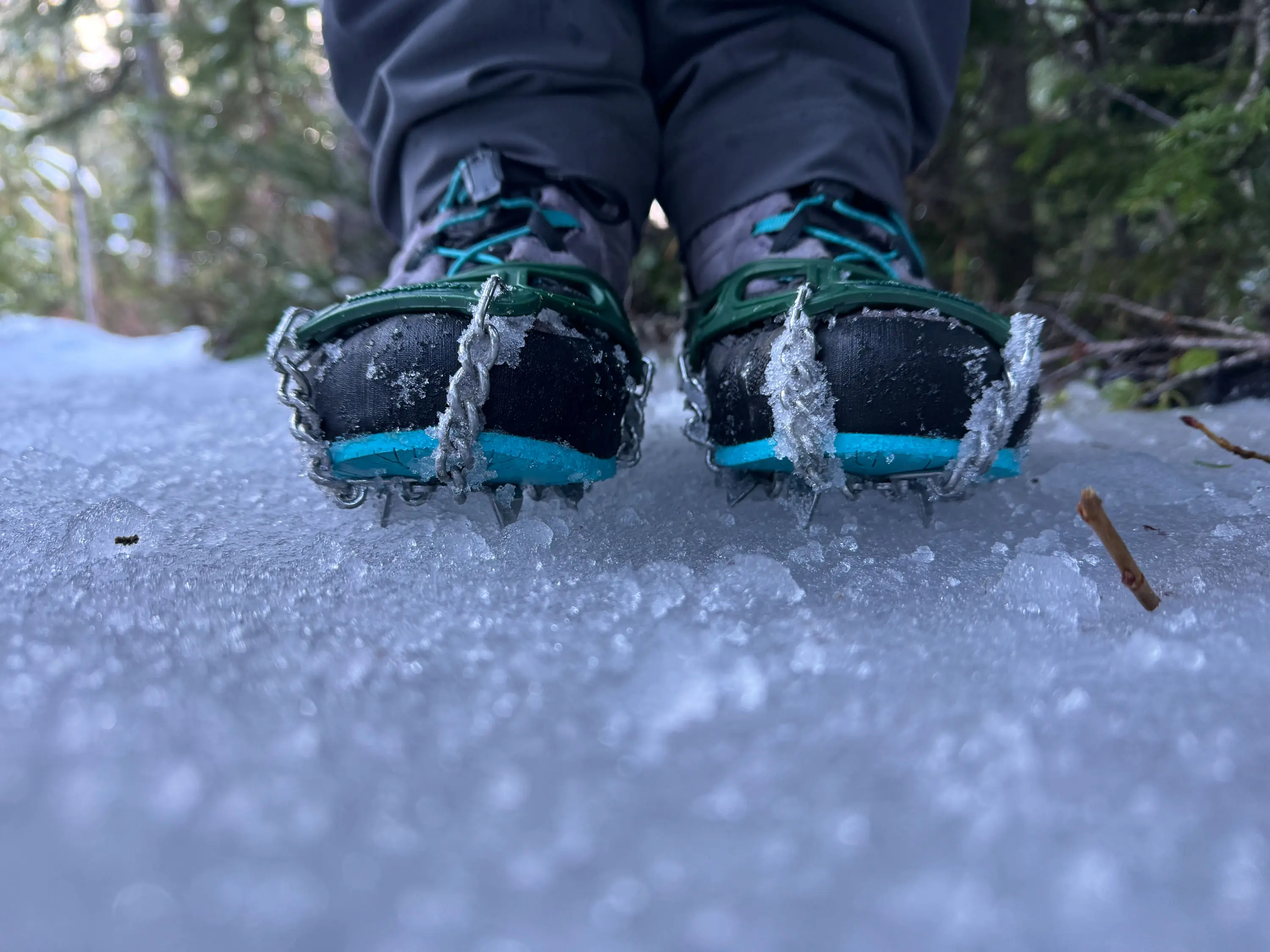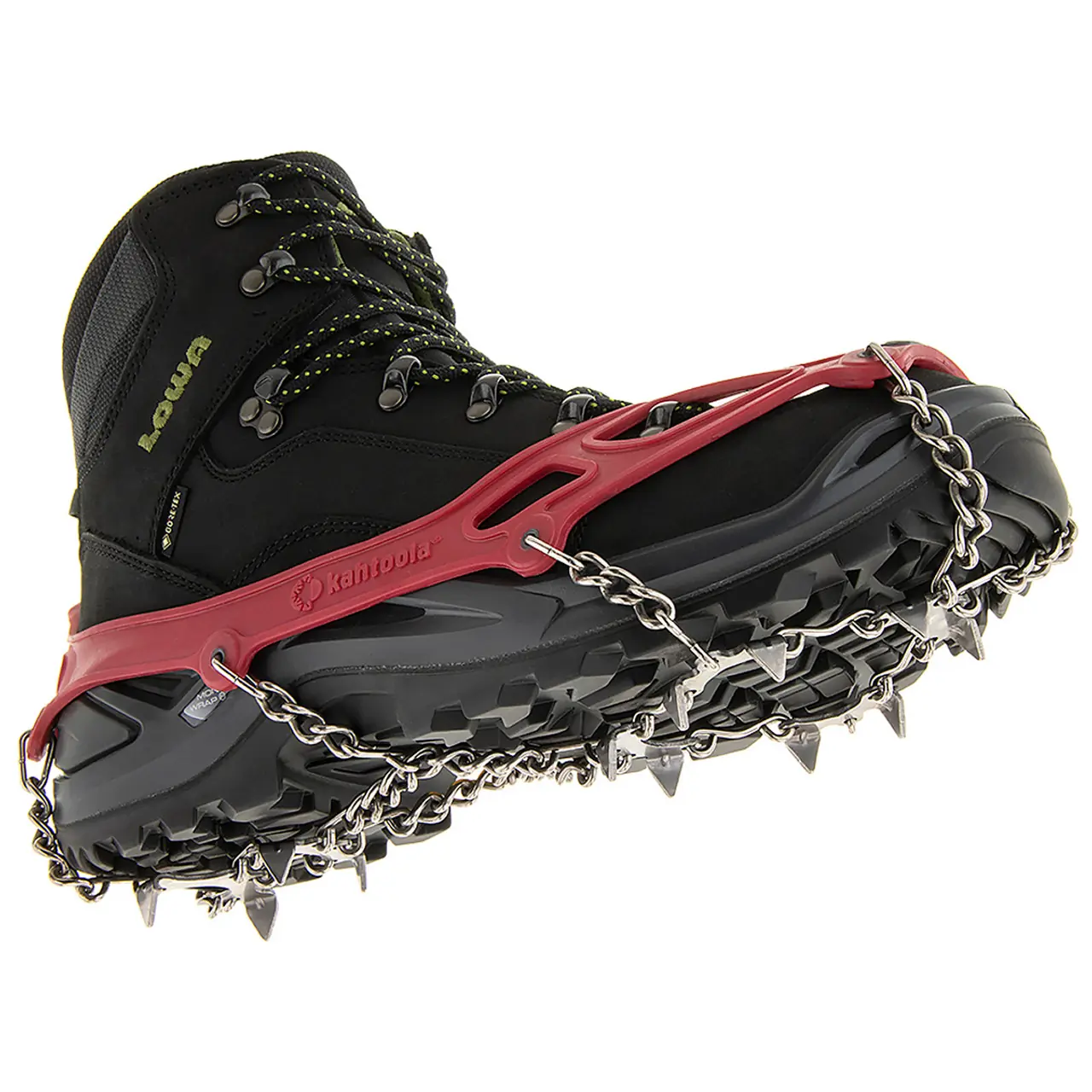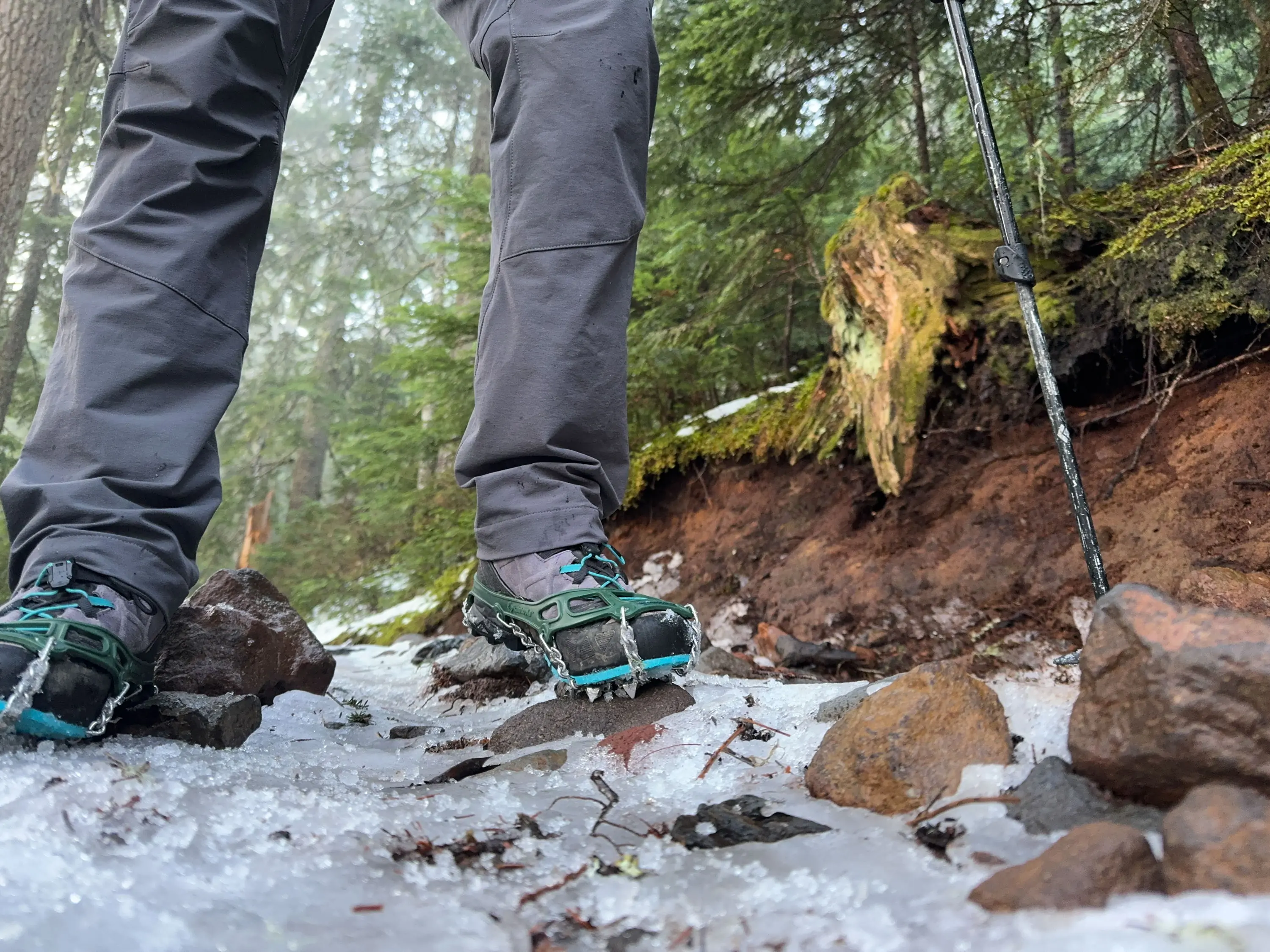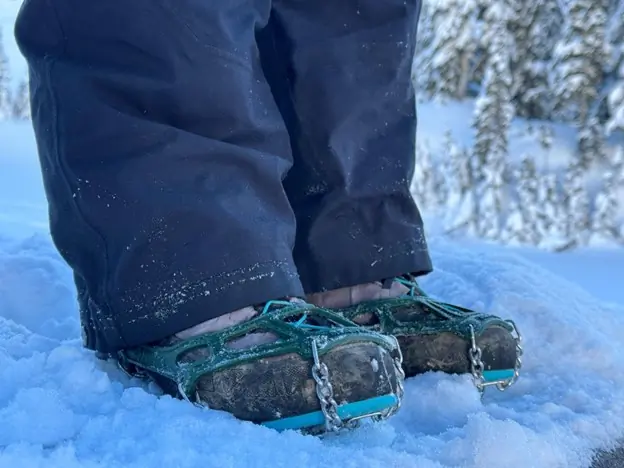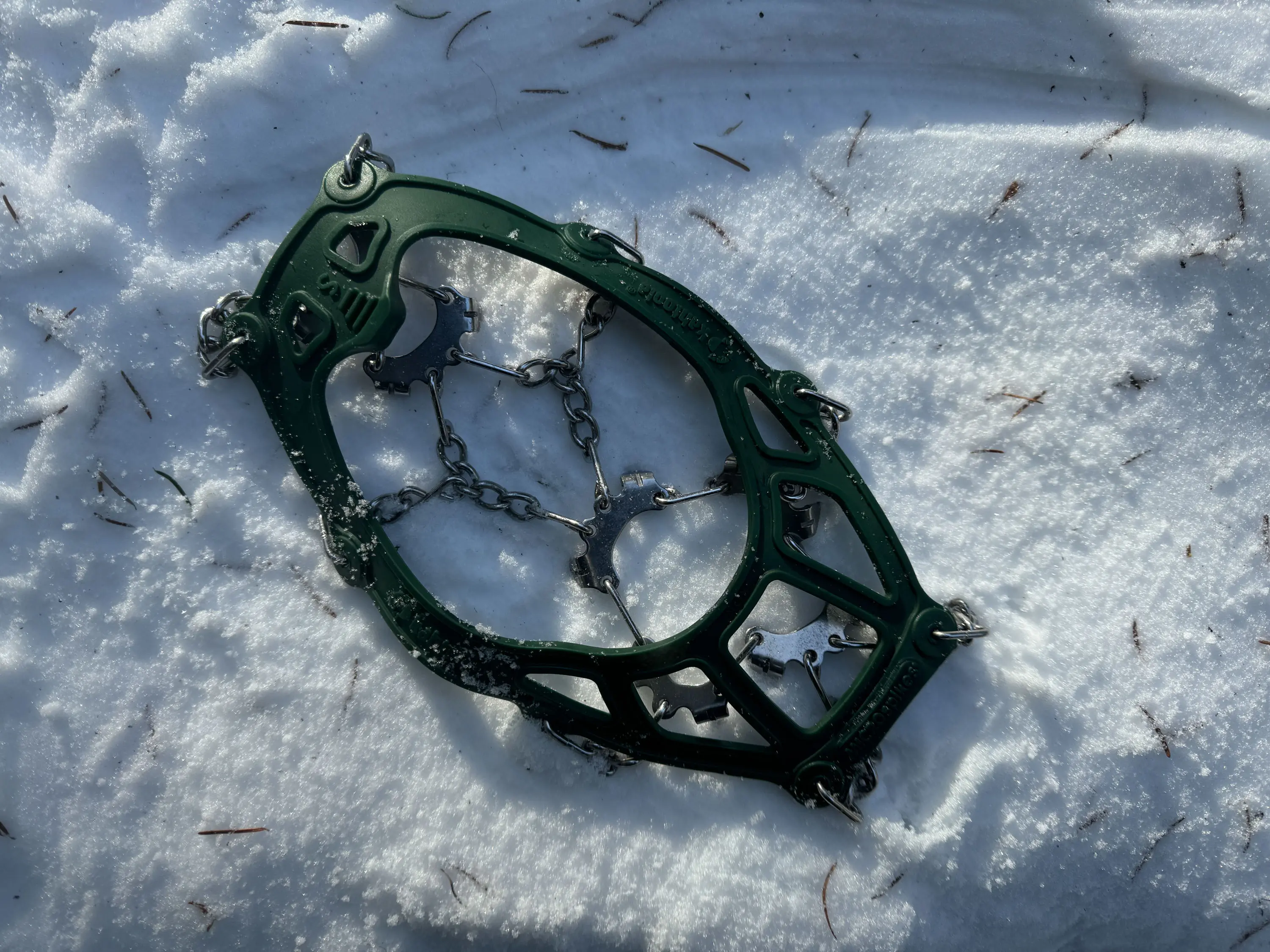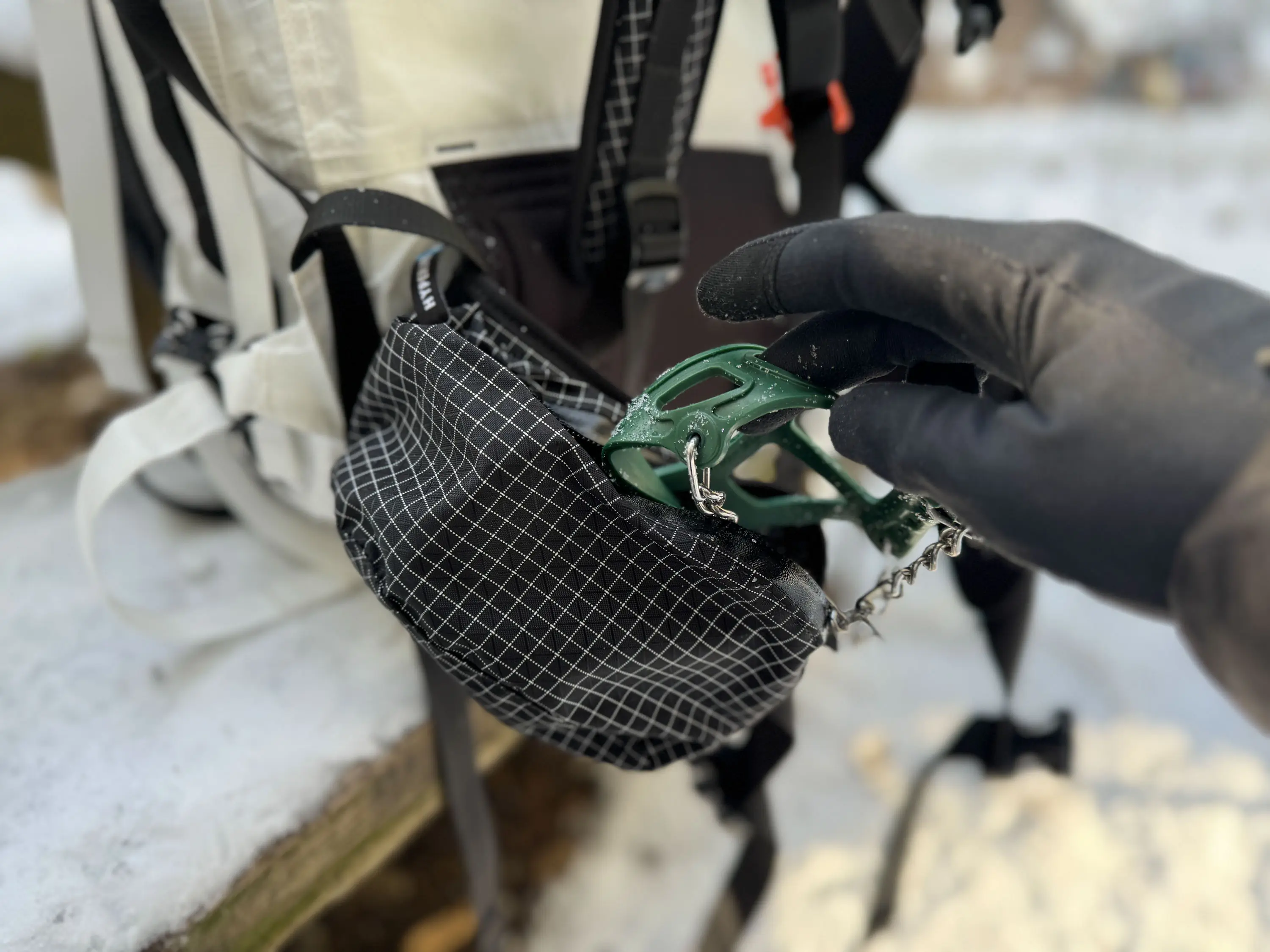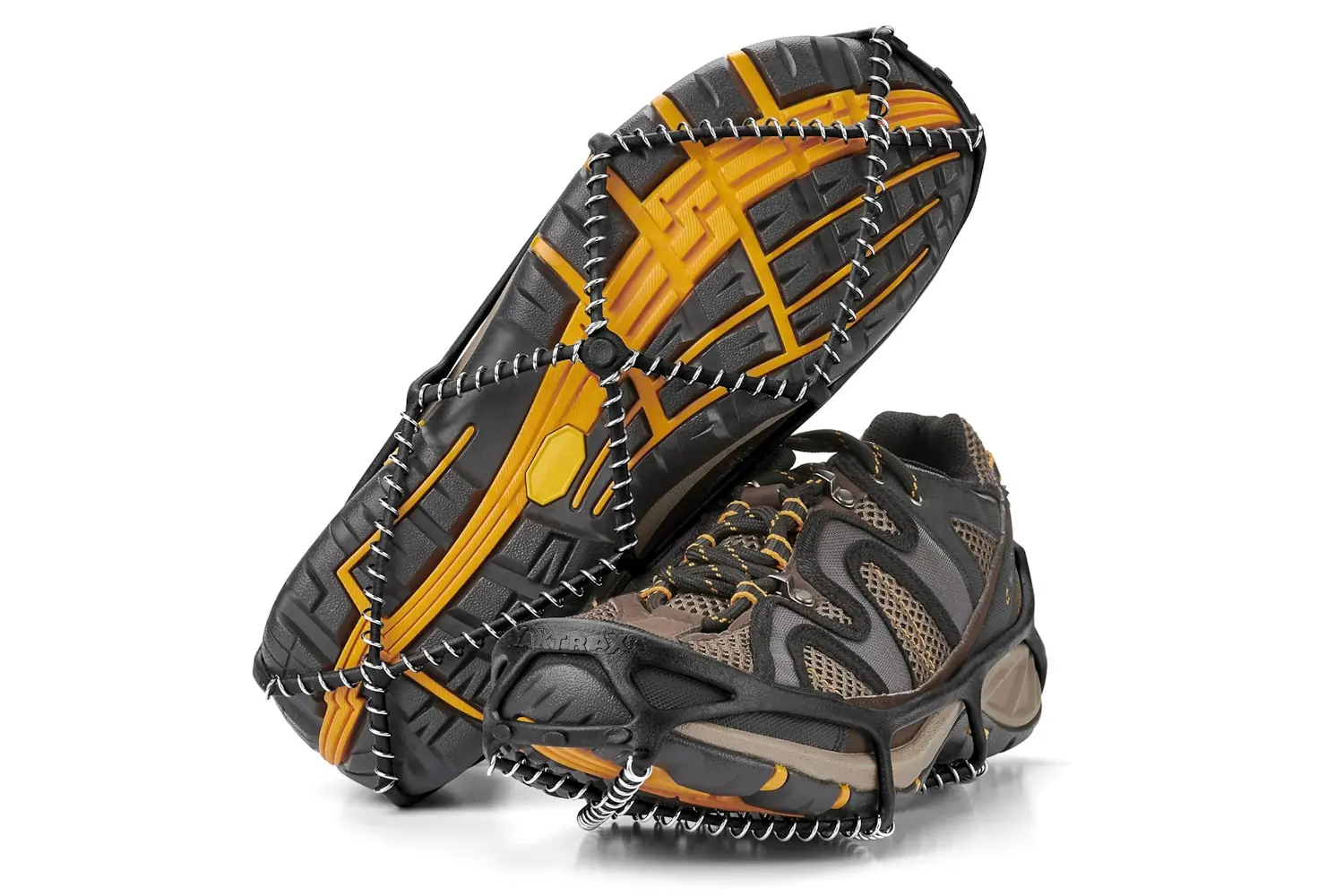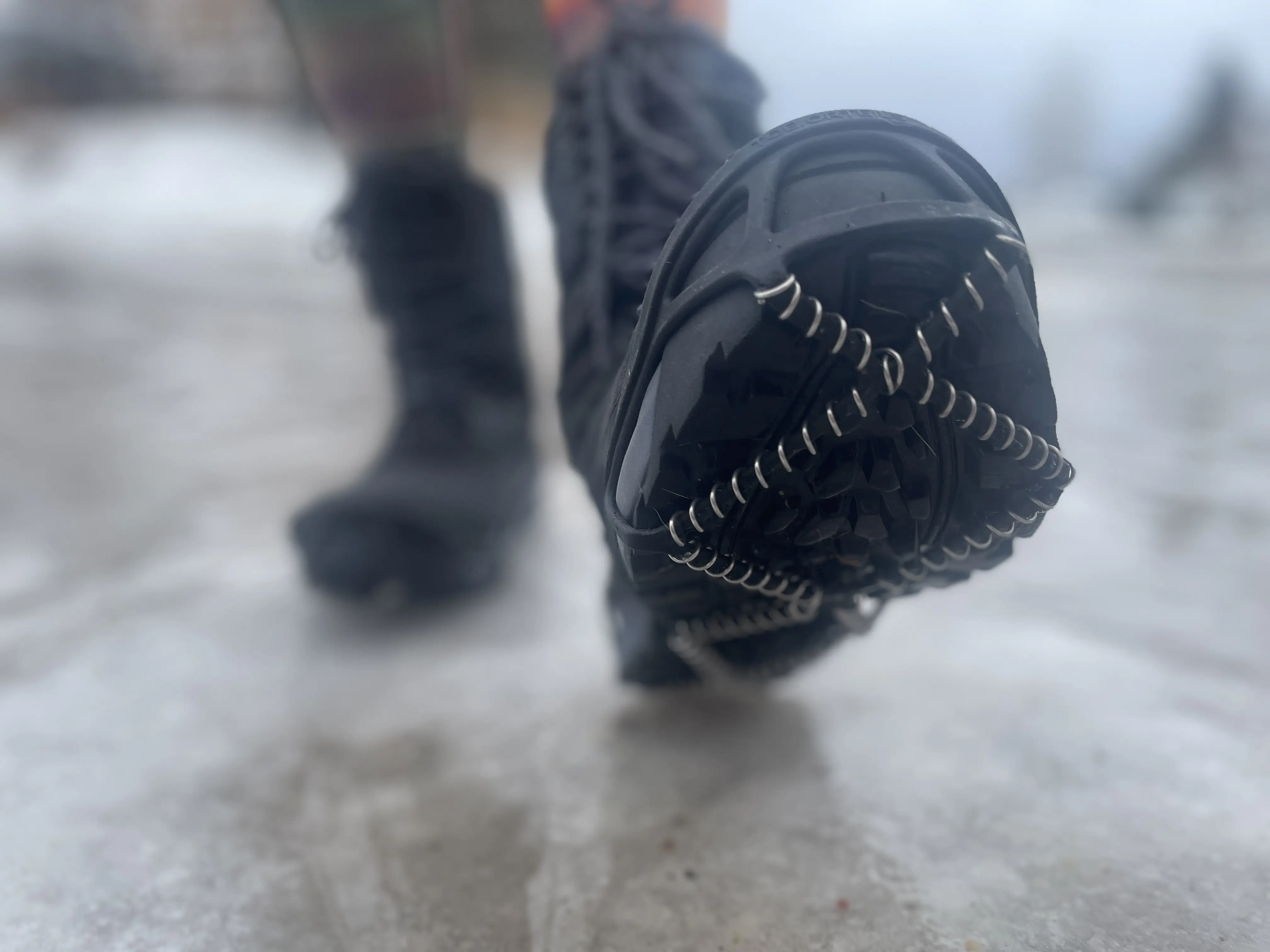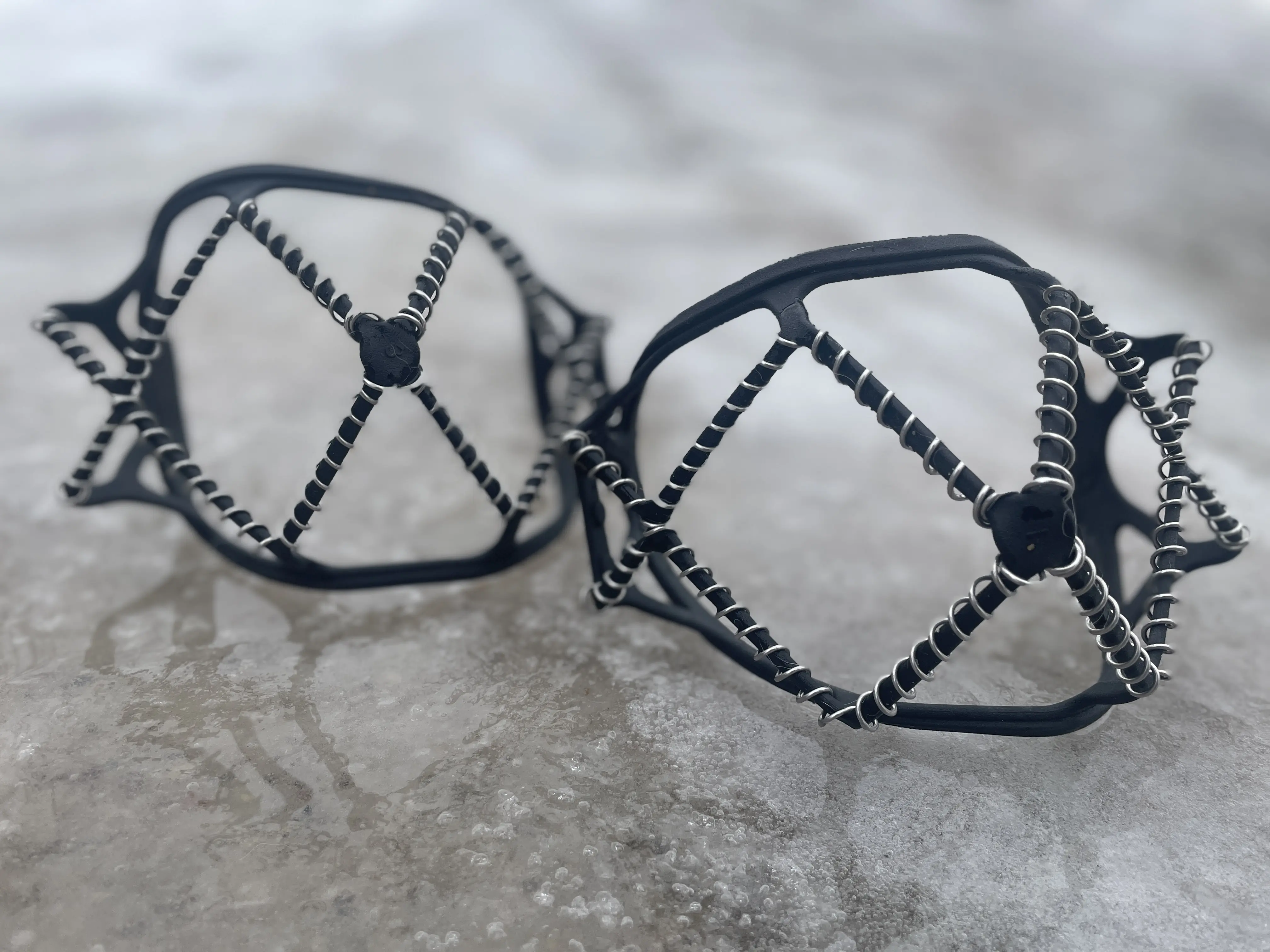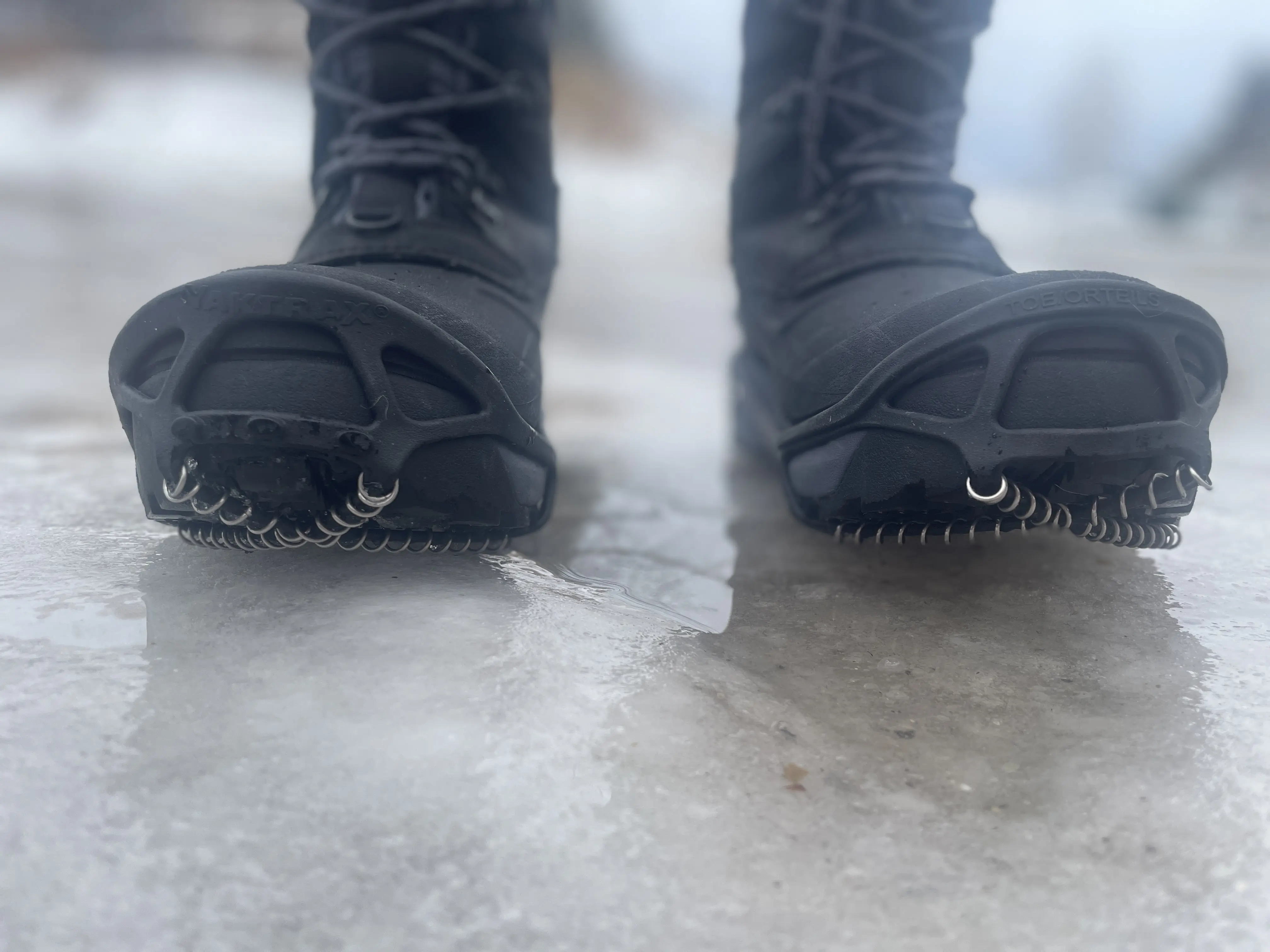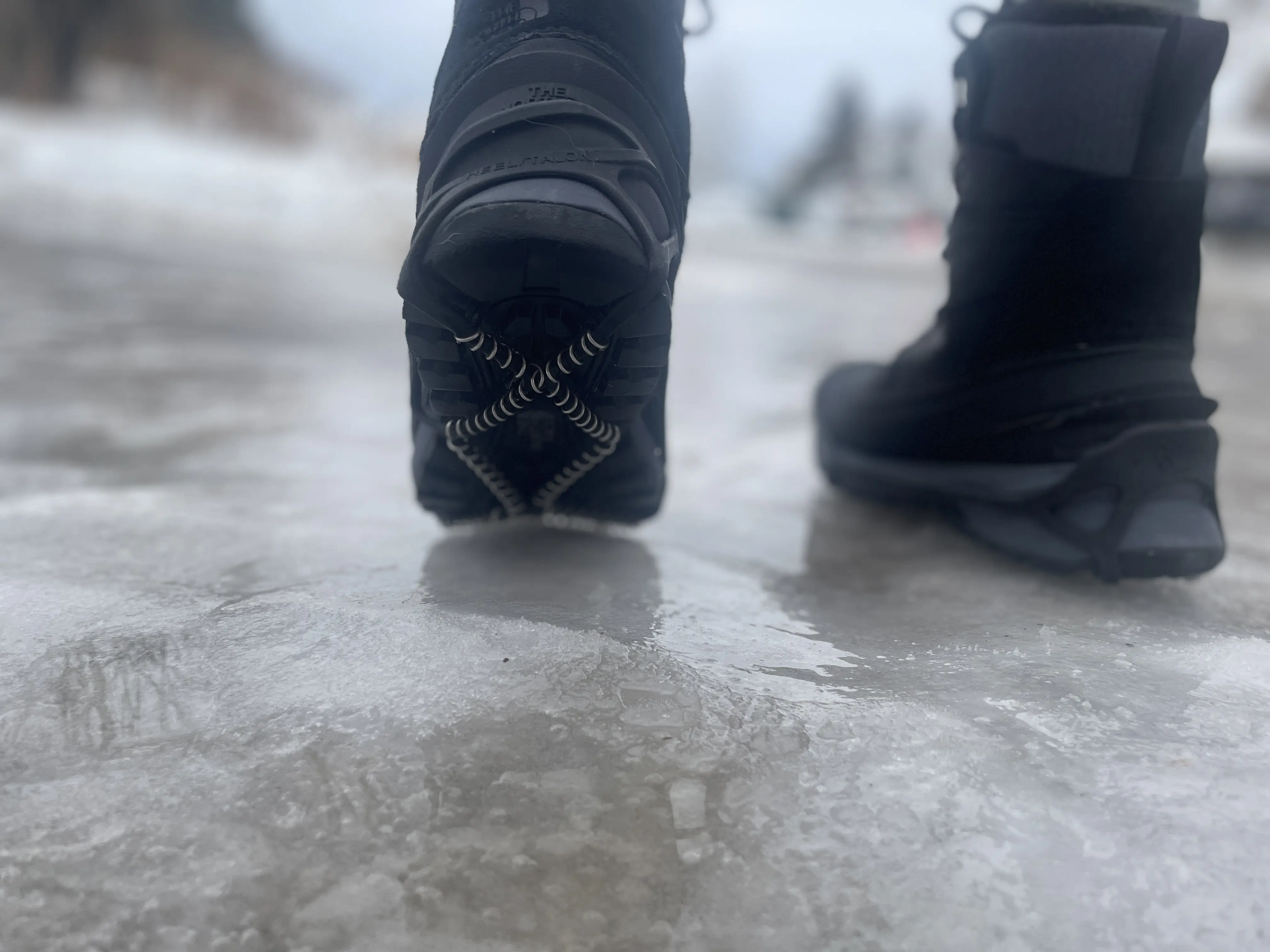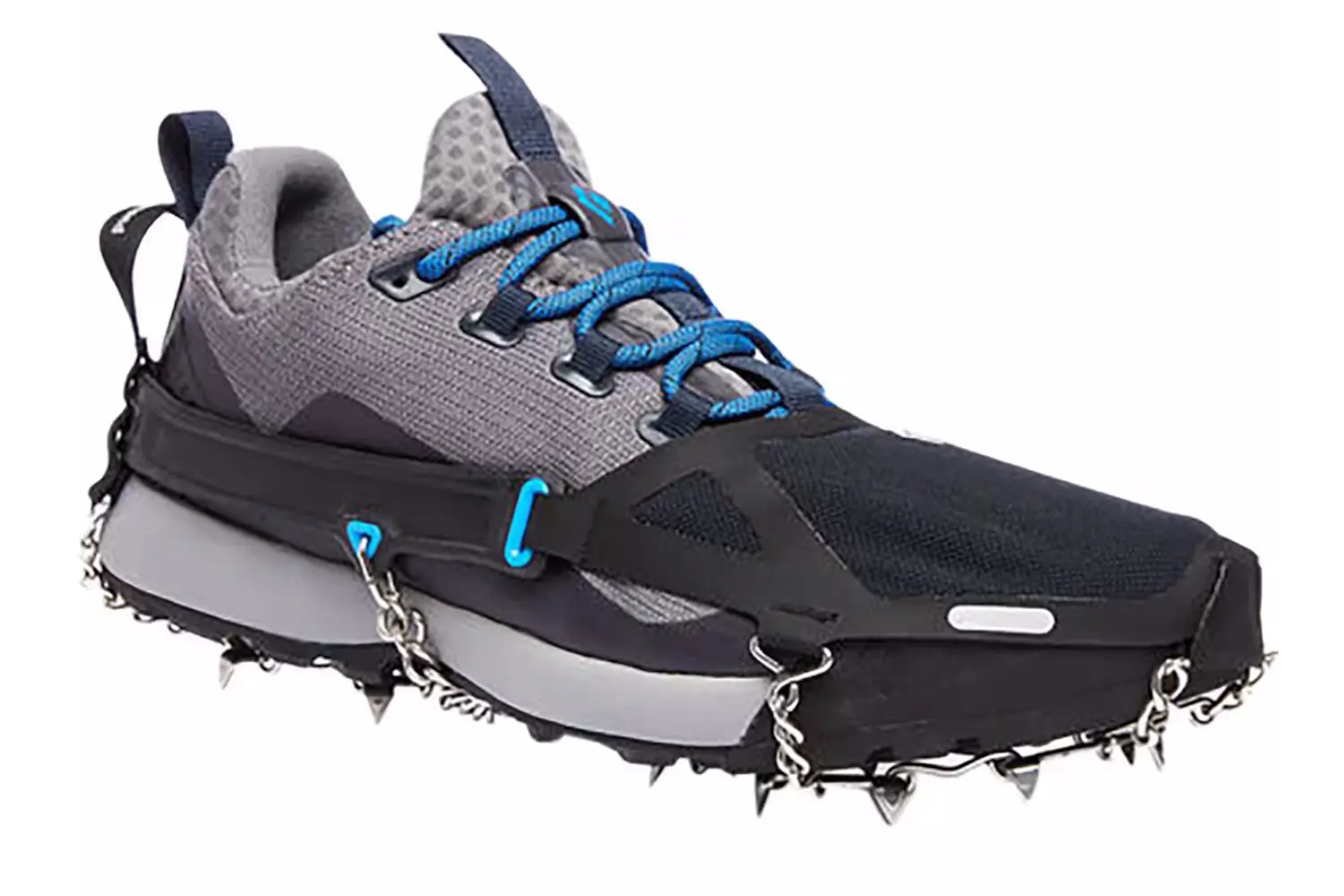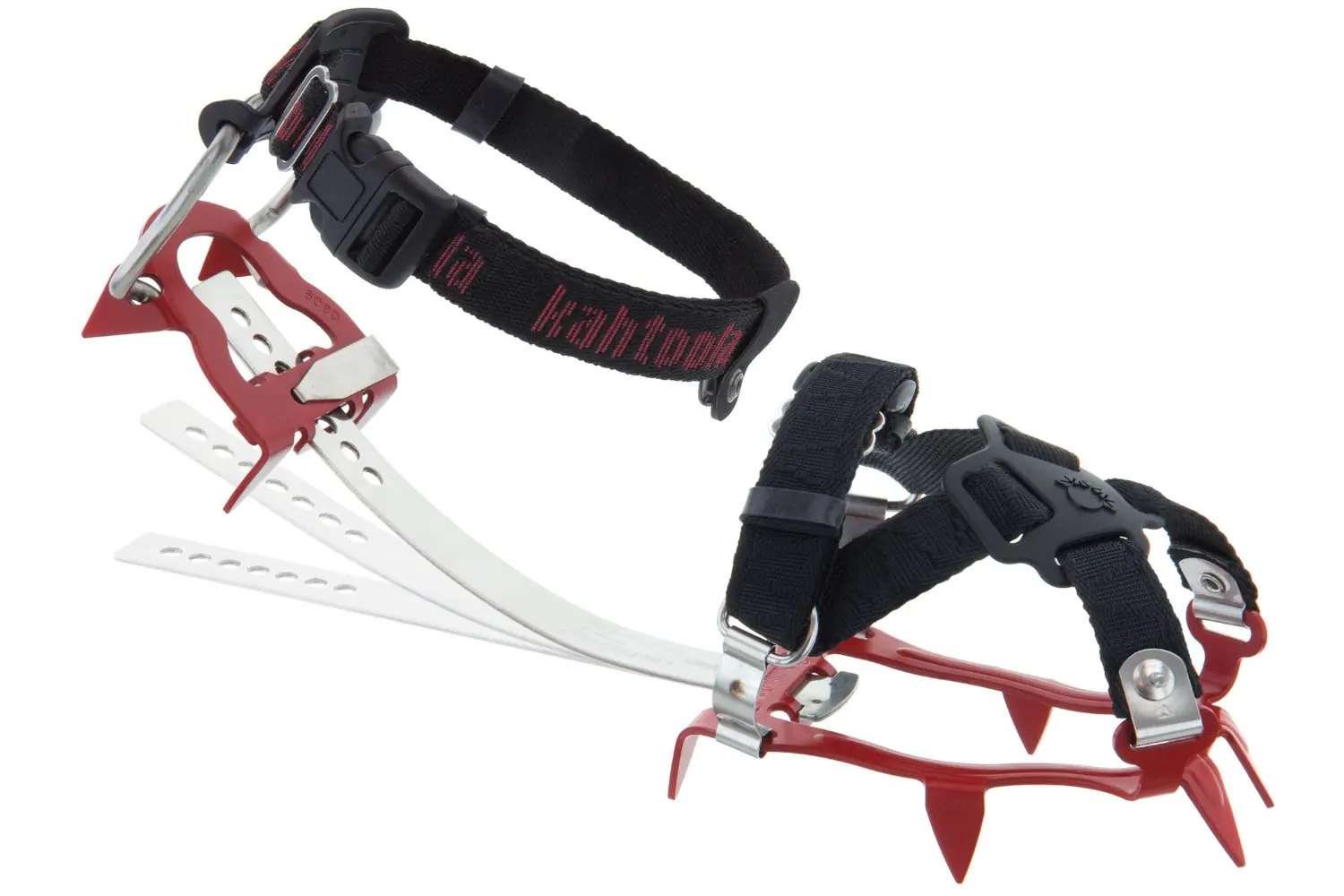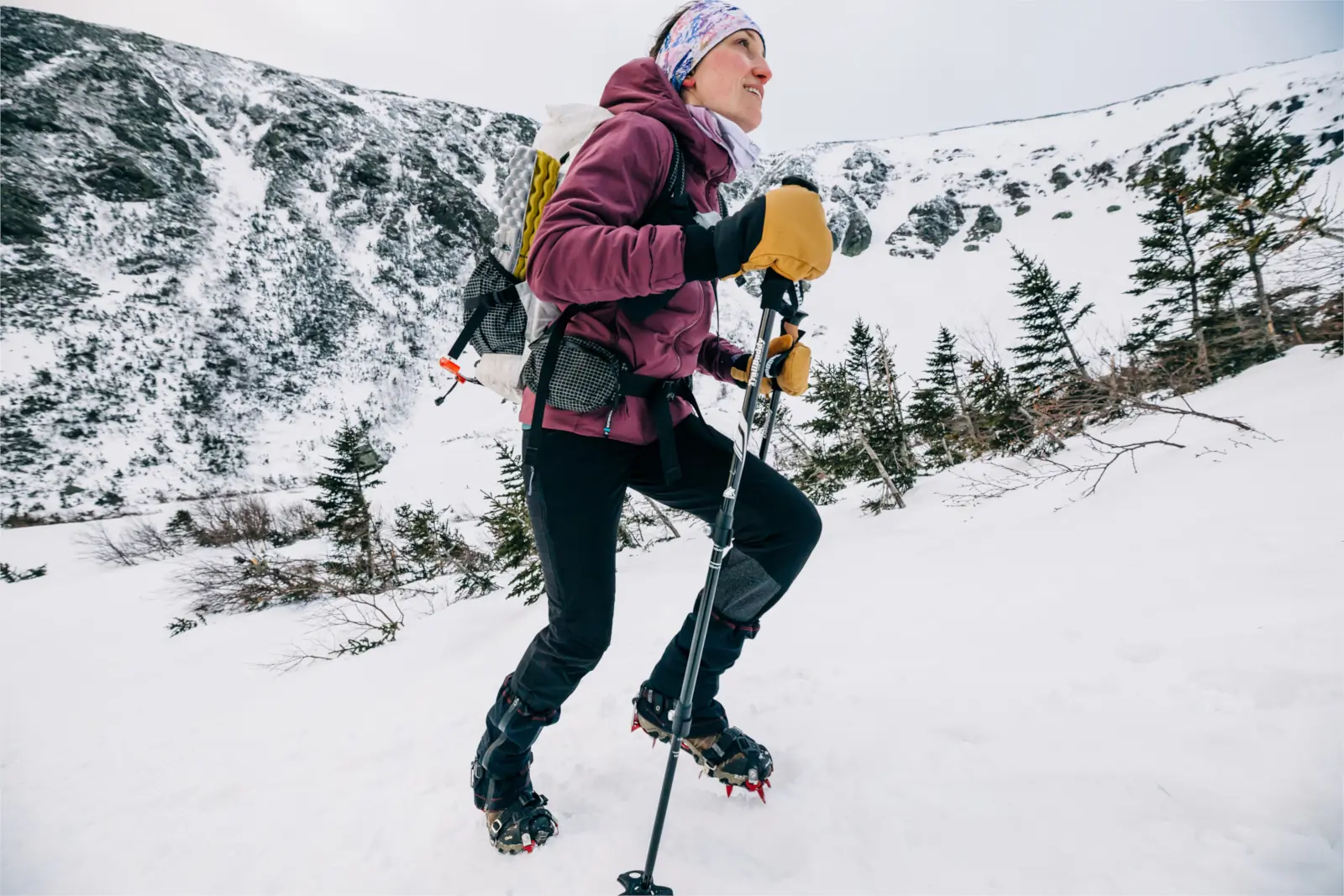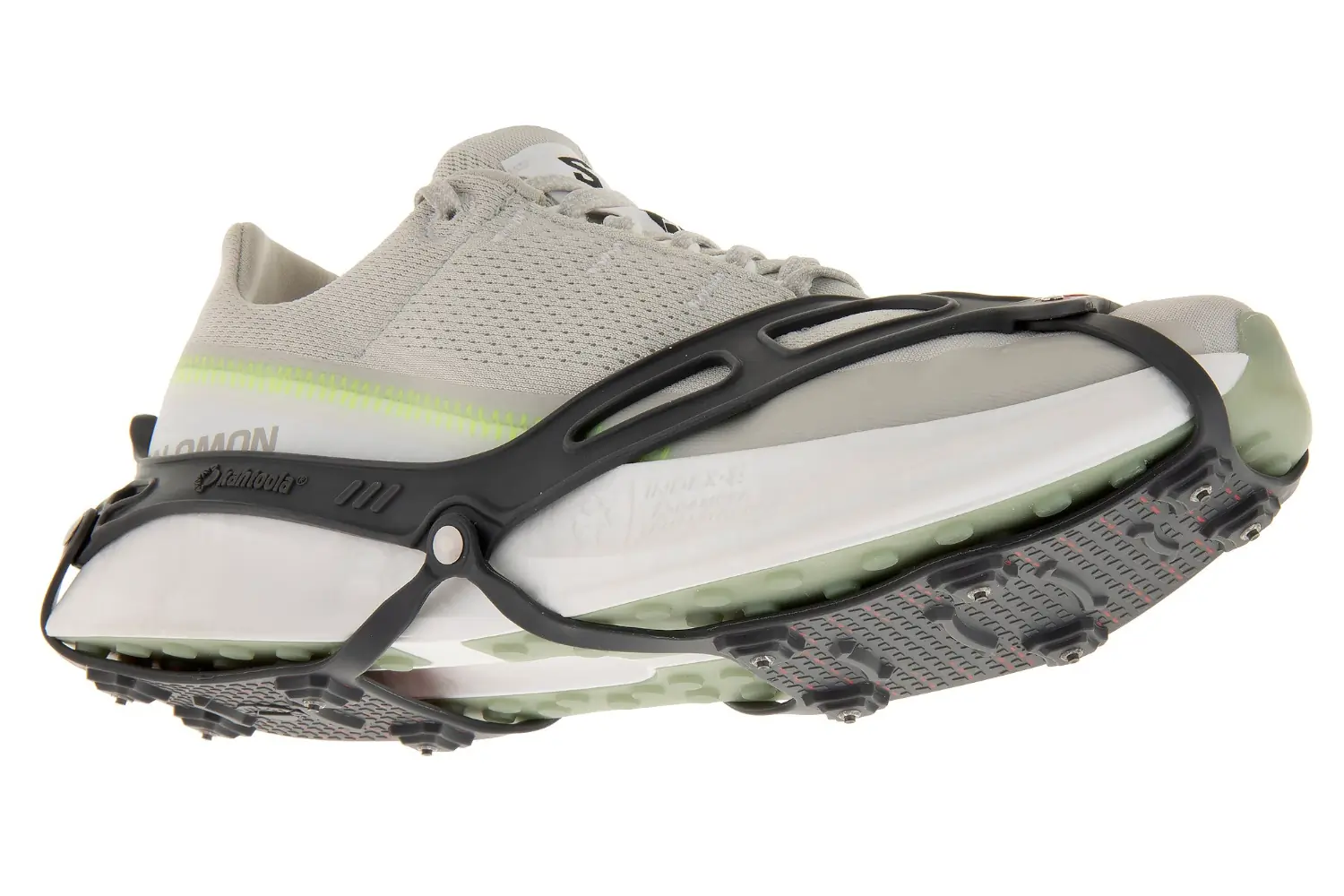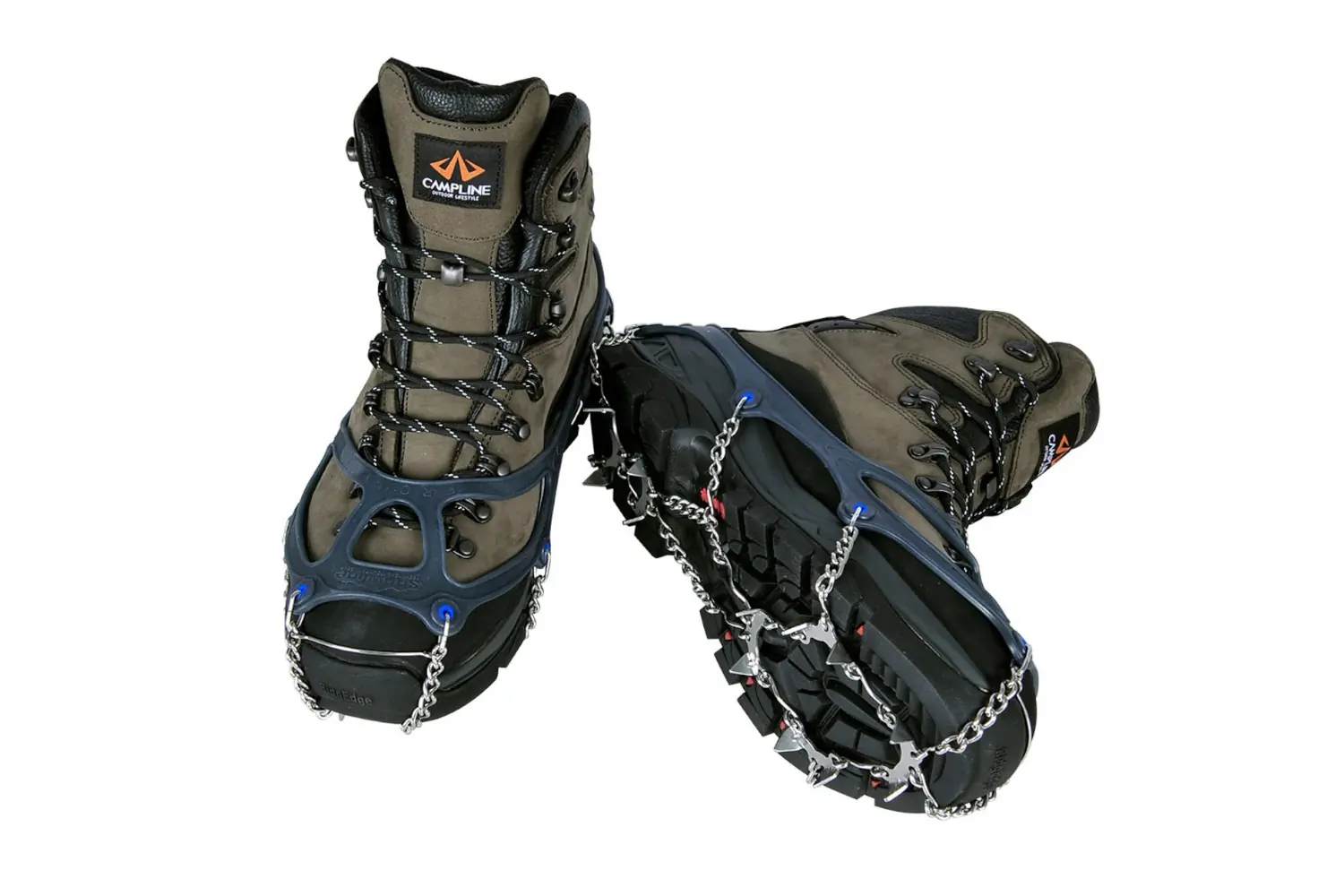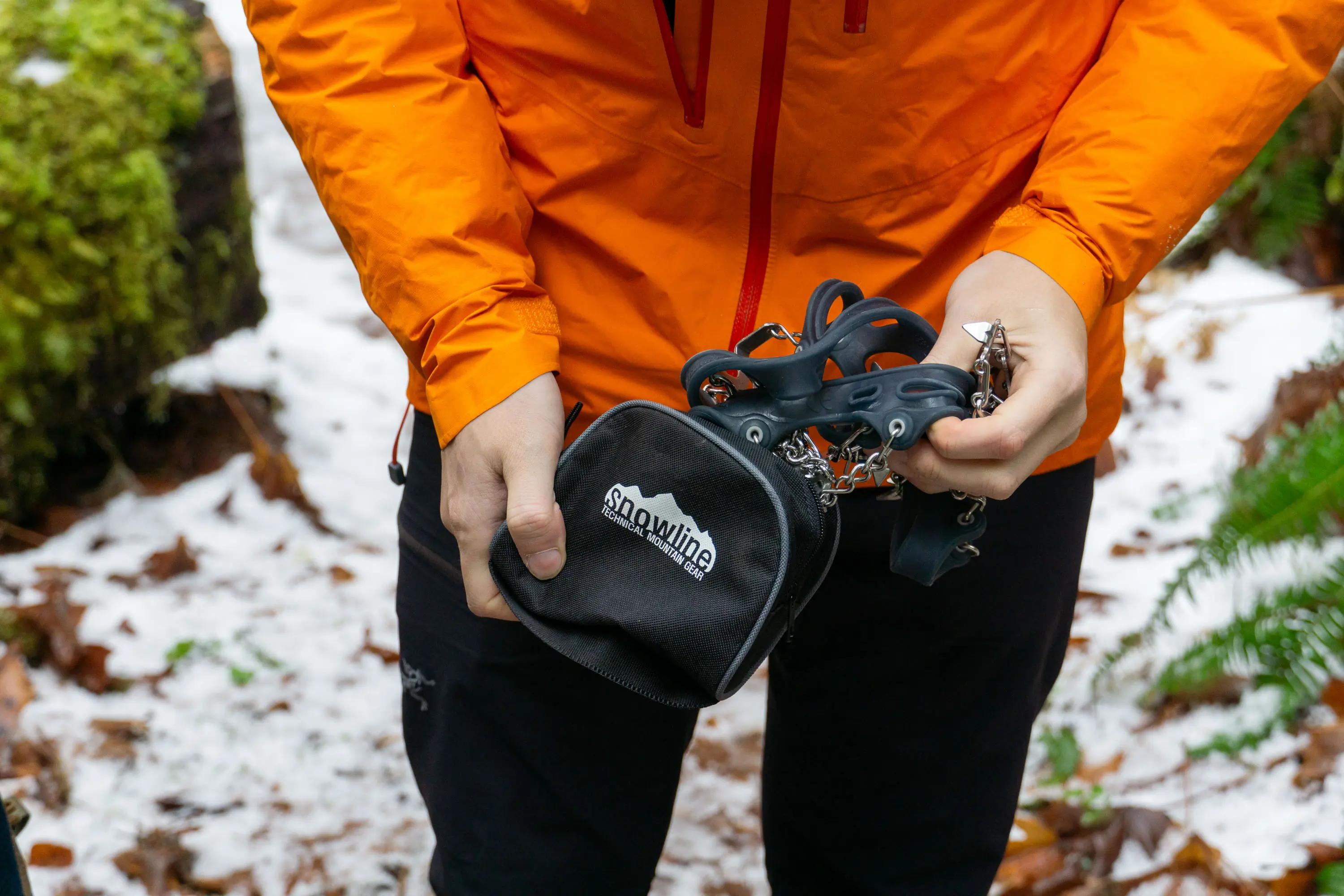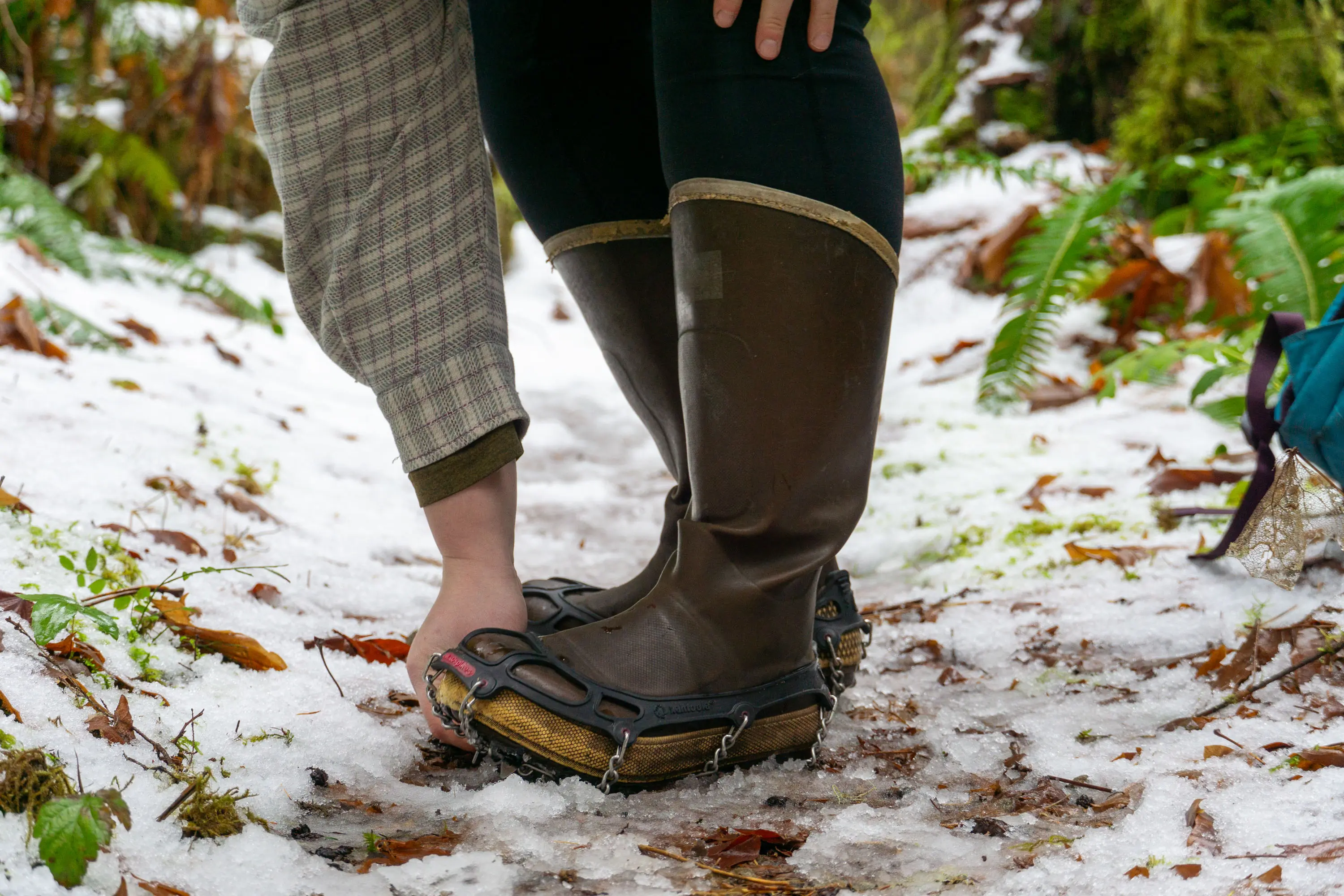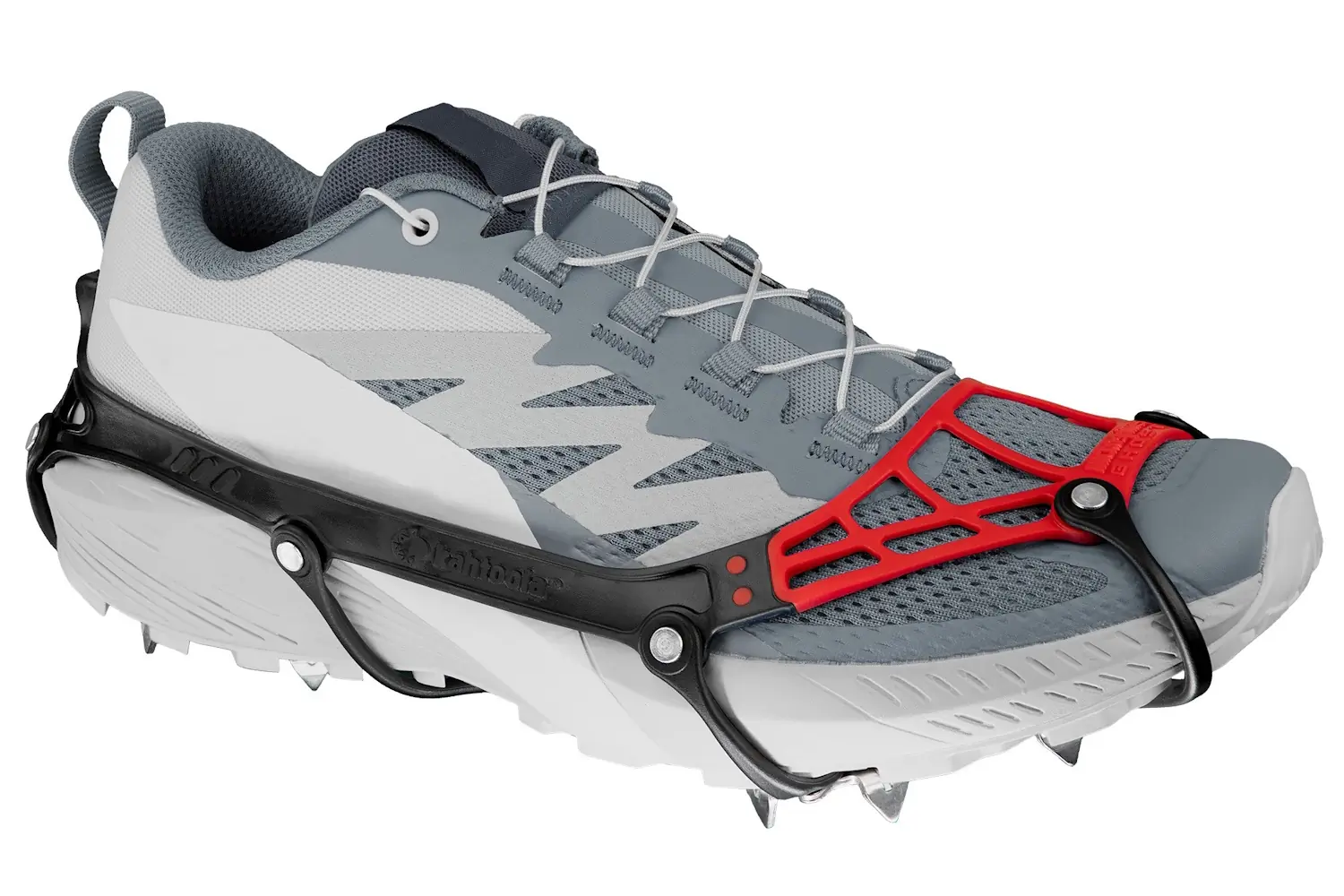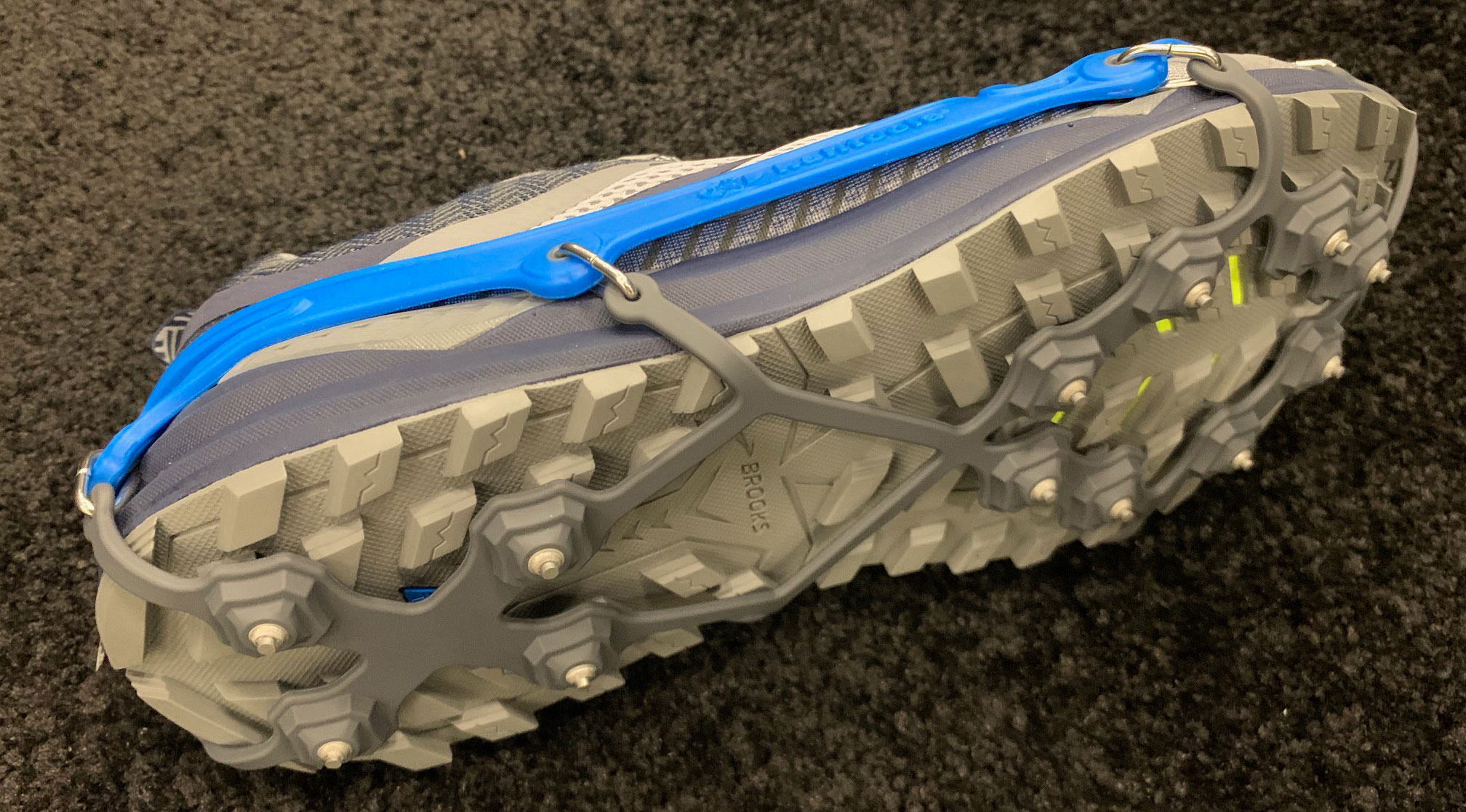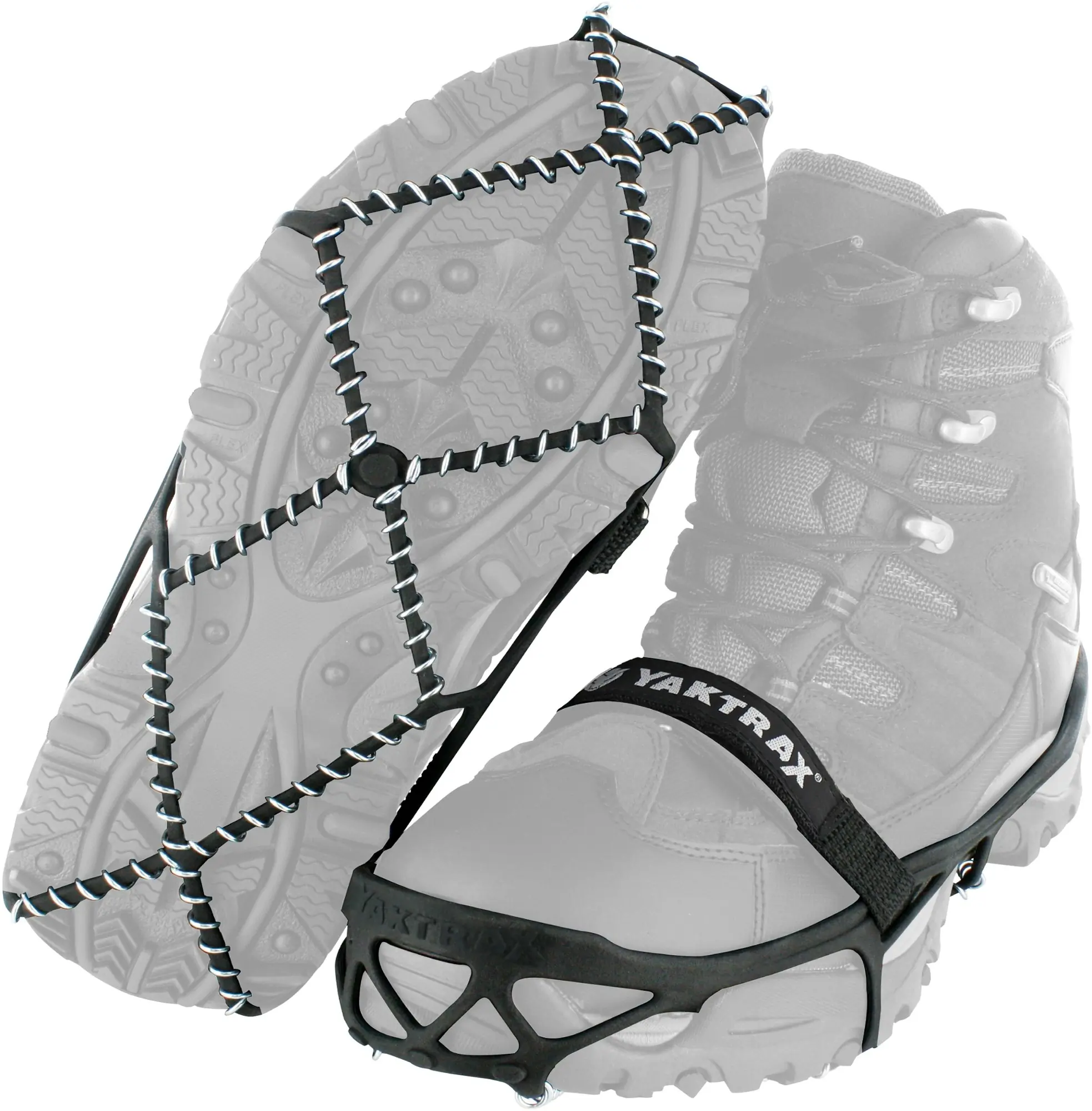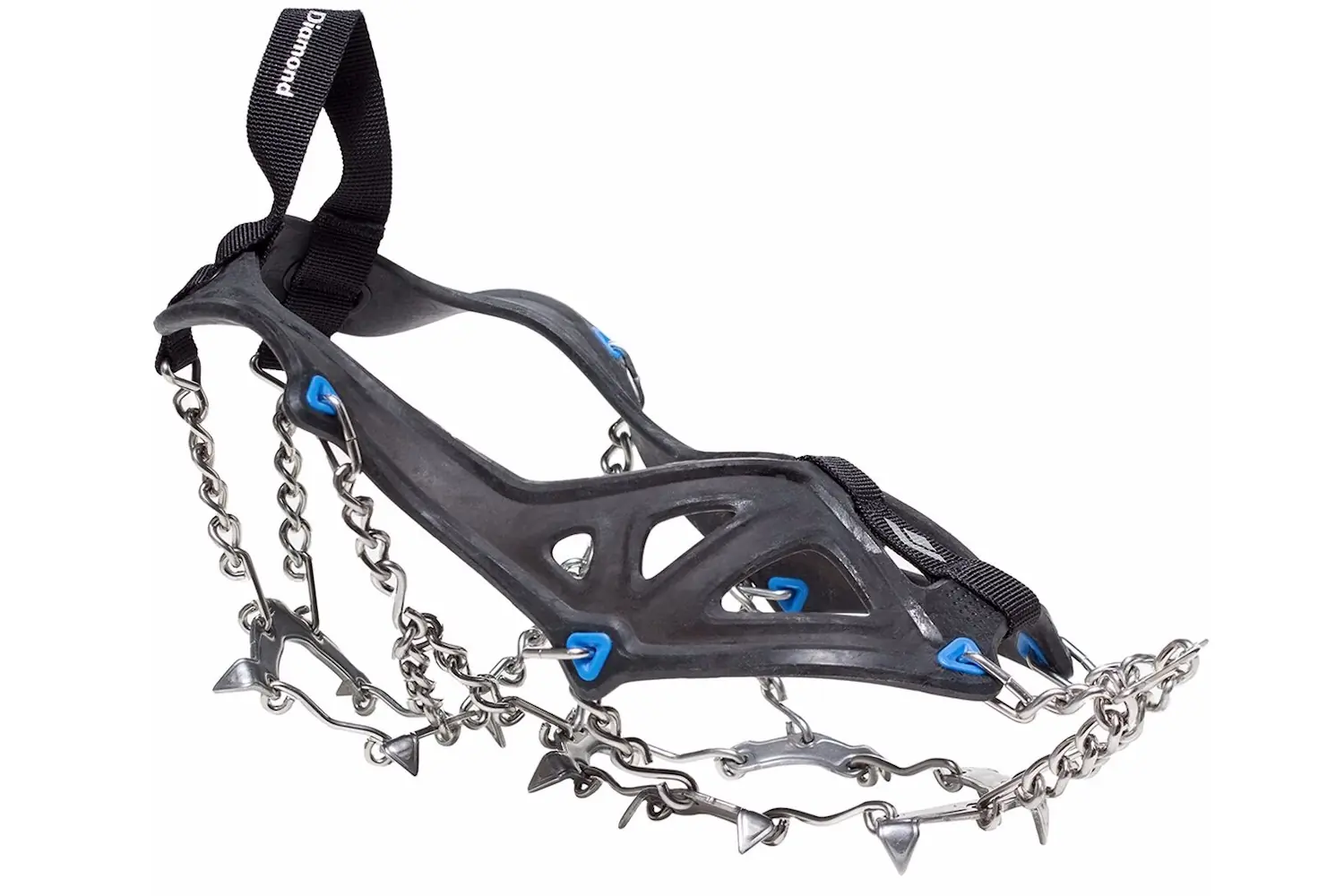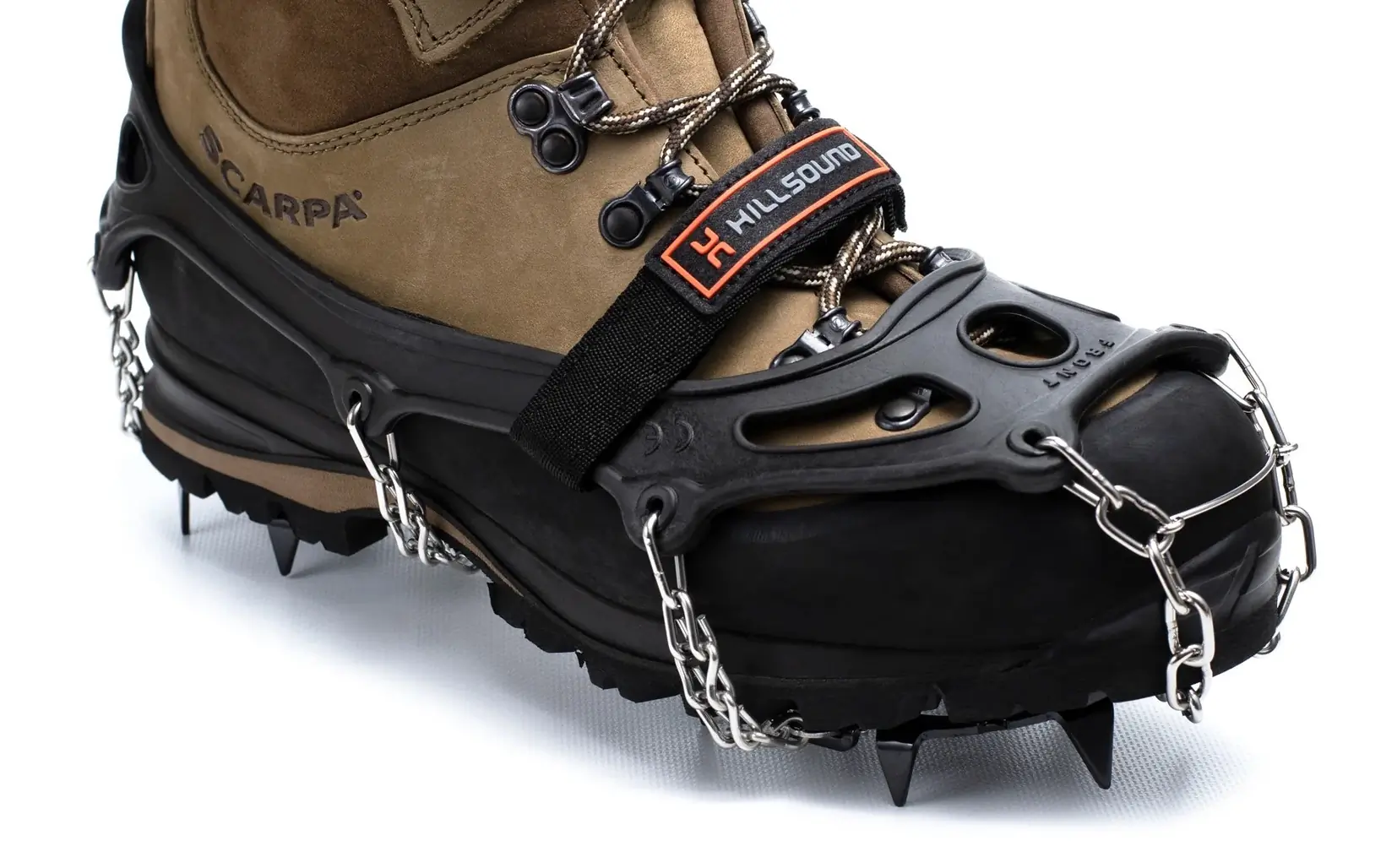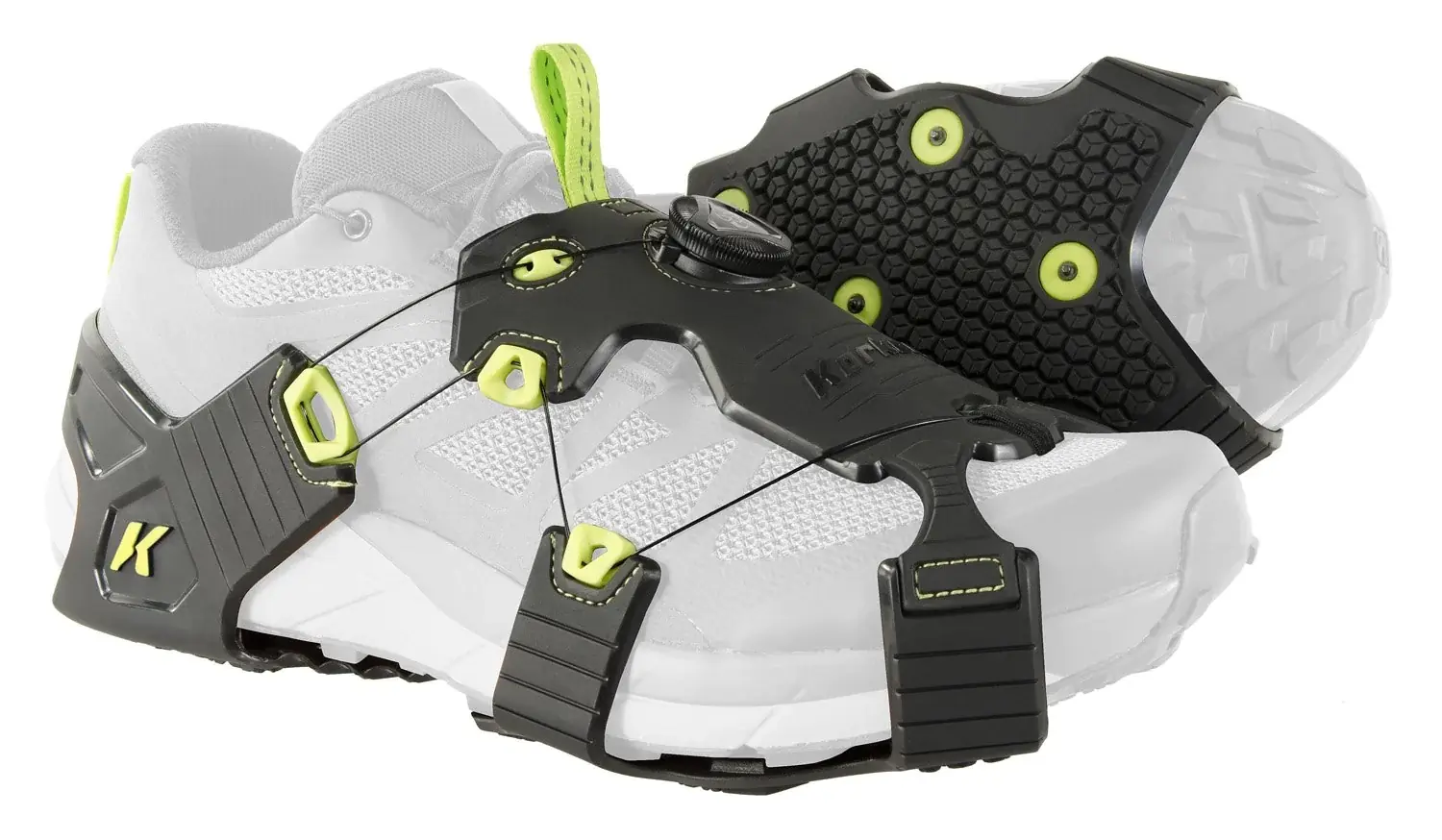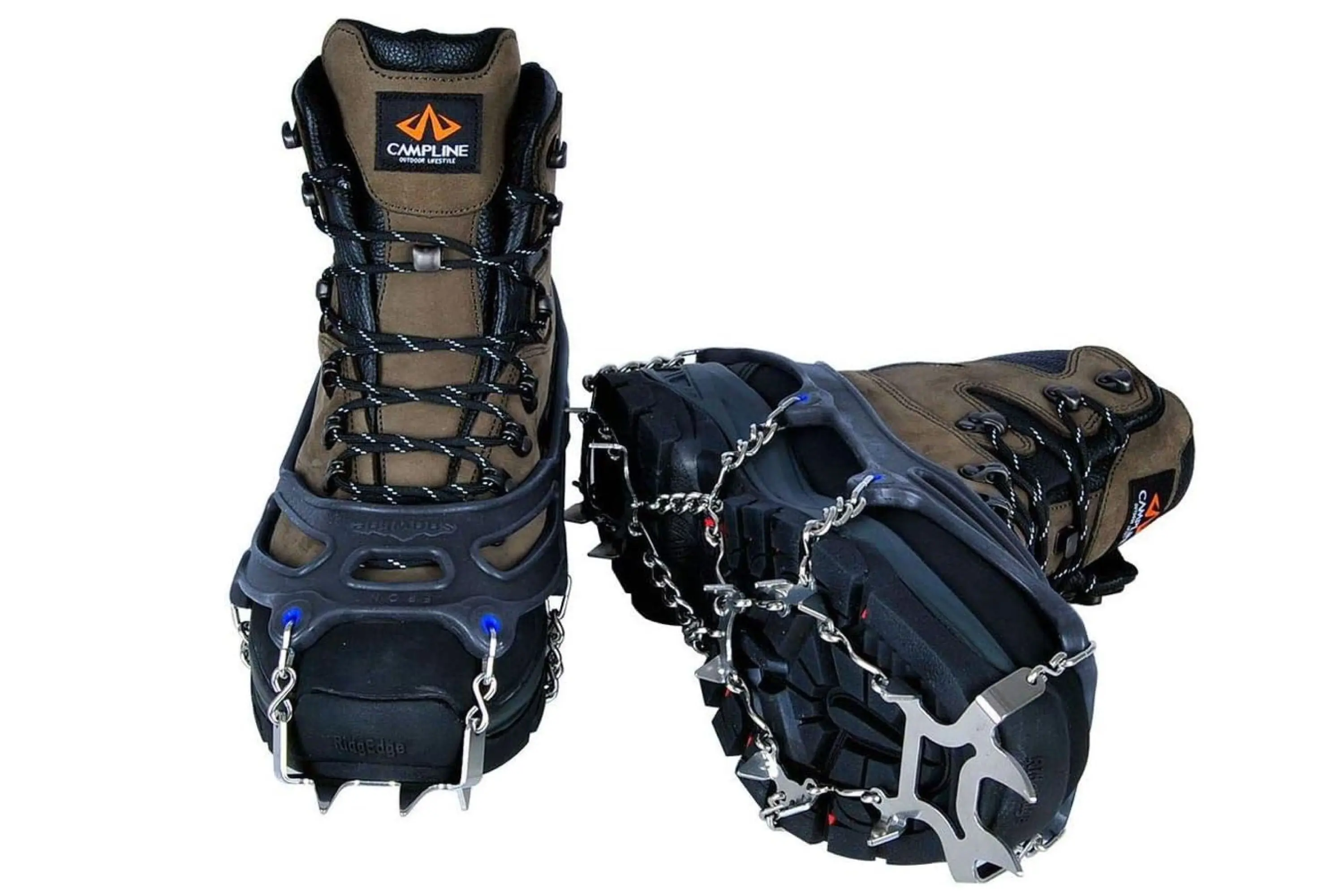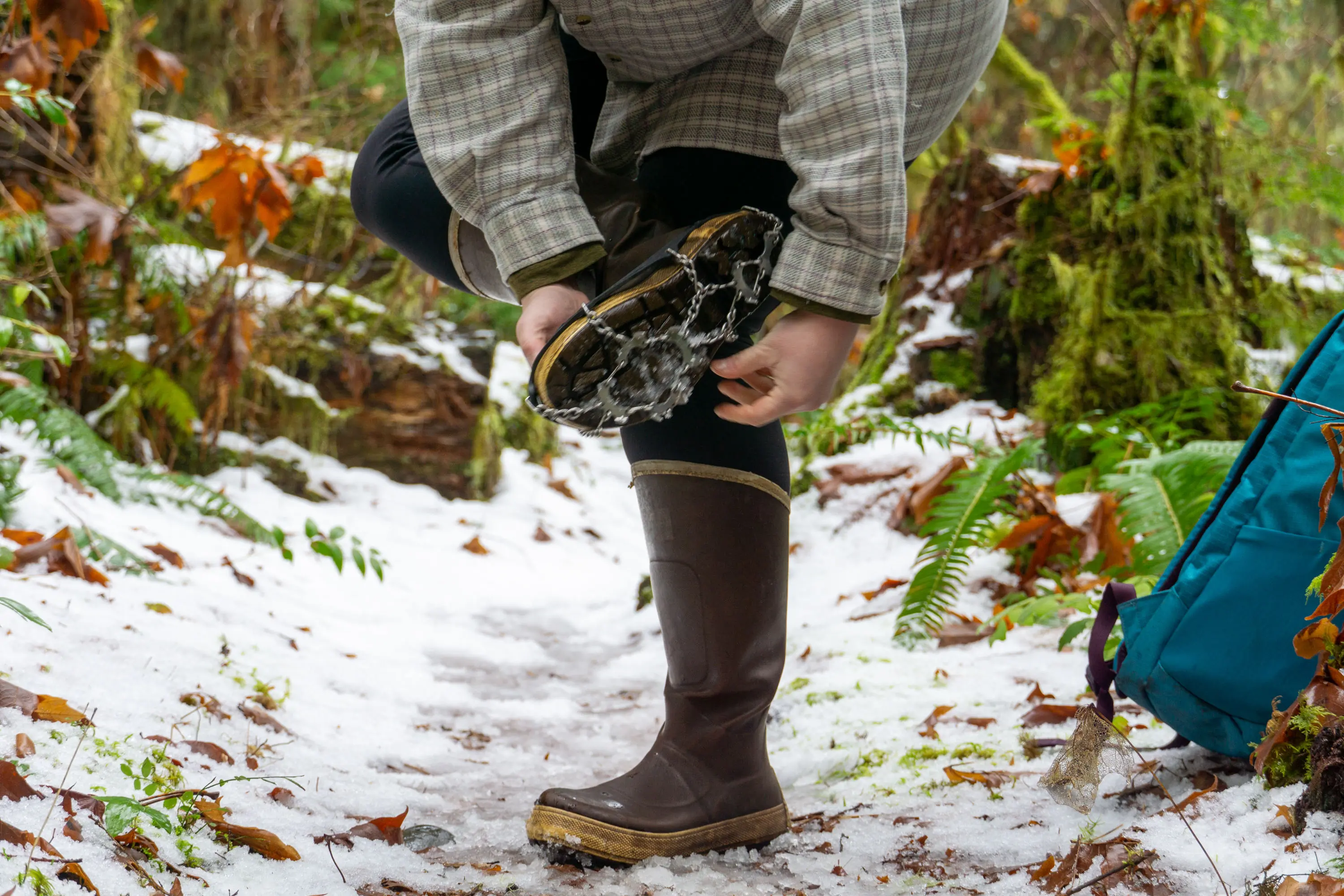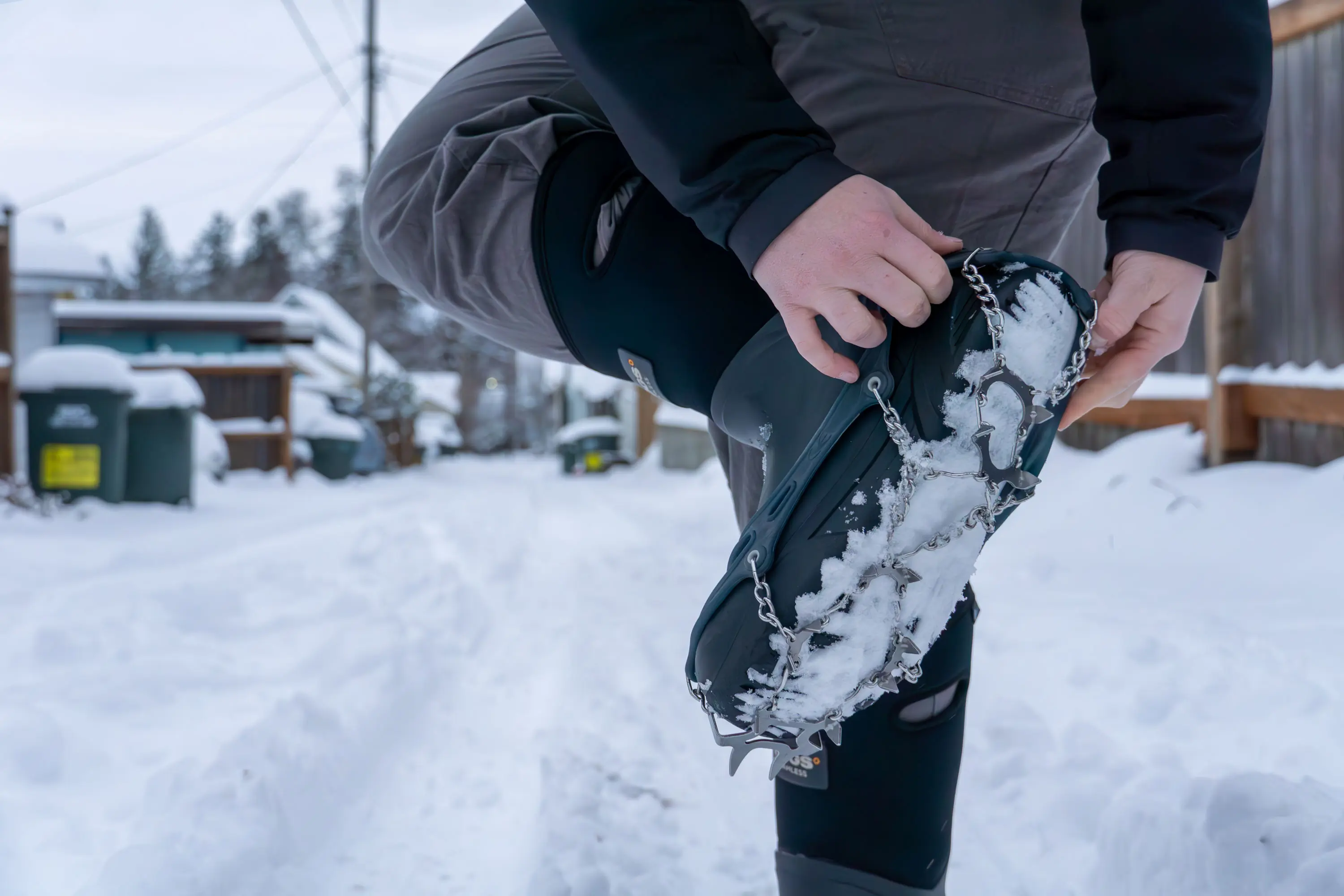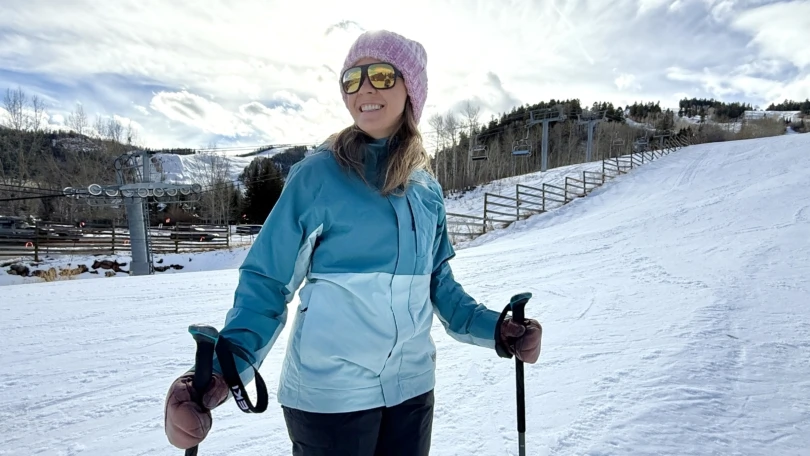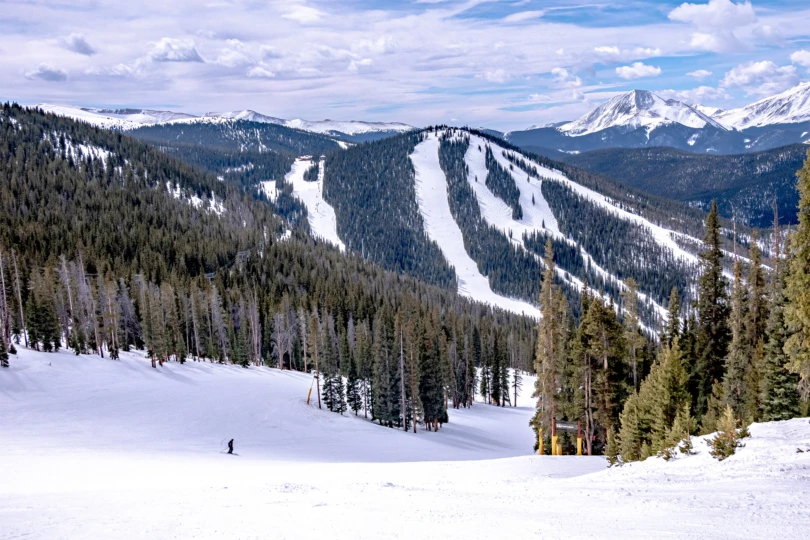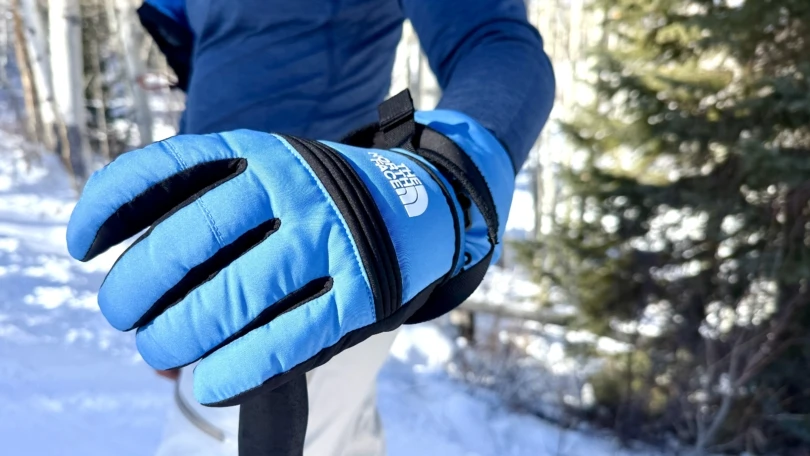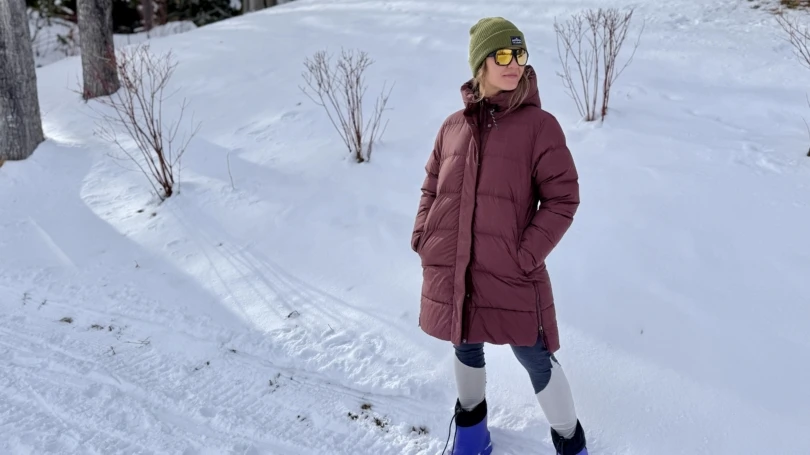Whether you call them microspikes, ice cleats, or trail crampons, the best winter traction devices keep your feet planted when the ground turns slick. From the biting cold of a Wyoming winter to the season’s first dusting on Colorado fourteeners, we’ve spent the past decade testing piles of options from Yaktrax, Black Diamond, Kahtoola, Hillsound, and more. Our testers include wilderness guides and thru-hikers who keep moving long after the first flakes fall.
Through countless miles of hiking, running, and deliberate slip-sliding, we’ve narrowed the field to the best traction devices of the season. Whether you want the bite and security of the Kahtoola MICROspikes for icy mountain trails or the wallet-friendly Yaktrax Walk for neighborhood strolls, we’ve got you covered. Safe to say, these picks will help you stay upright and moving all winter.
Editor’s Note: On August 17, 2025, we updated our Winter Traction Devices guide, adding the Kahtoola MICROspikes Ghost and the Black Diamond Access Spike, two new models that impressed us with their blend of performance and ease of use. We also added overall product ratings to make comparisons across products easier.
The Best Winter Traction Devices of 2025
Best Winter Traction Devices for Non-Technical Mountaineering
Kahtoola KTS Hiking Crampons
8.2/10 RatingKahtoola MICROspikes
- Weight per pair: 11 oz. (medium)
- Traction: Twelve stainless steel spikes
- Harness: Thermoplastic elastomer harness
- Best for: All-around winter traction use; ski-area parking lots; winter hiking trails
Pros
- Performs well over icy and mixed terrain
- Fits over diverse footwear
- Harness design keeps spikes in place
- Extremely durable
- Easy to put on
Cons
- Doesn’t grip well in mud and slush
- Heavier than other brands
Yaktrax Walk
- Weight per pair: 5.4 oz. (medium)
- Traction: 1.2 mm steel coils over rubber harness
- Harness: Polyelastomer webbing harness
- Best for: Casual walks on packed snow or ice, in-town
Pros
- Easy to use
- Allow you to walk naturally
- Low profile
- Traction system covers entire underfoot area
- Fits on most shoes and boots
- Affordable
Cons
- Lacks durability compared to others
- Don’t work in more than a couple inches of snow
Black Diamond Distance Spikes
- Weight per pair: 3.9 oz.
- Traction: 14 heat-treated stainless steel spikes
- Harness: Softshell toe cover and heel retention elastomer
- Best for: Walking, hiking, and running on snow-packed and icy terrain
Pros
- Lightweight
- Harness design keeps snow out
- Grippy on snow and ice
Cons
- Not very durable
- Not super secure fit
- Expensive
Kahtoola KTS Hiking Crampons
- Weight per pair: 23.1 oz. (small/medium)
- Traction: 10 1-inch chromoly steel spikes
- Harness: Independent front and heel binding. Front: strong webbing and two-way plastic buckle. Back: webbing and bailing wire.
- Best for: Non-technical mountaineering, winter peak bagging, hiking, backpacking
Pros
- Superior traction
- Comfortable
- Packable
- Highly adjustable
- Work with all sorts of footwear from trail runners to boots
Cons
- Heavy
- Expensive
- Ideal for use on specific terrain
Kahtoola NANOspikes
- Weight per pair: 7.4 oz. (medium)
- Traction: 10 concave tungsten carbide spikes and center plate ridges
- Harness: Enhanced thermoplastic elastomer
- Best for: Running on roads and mellow trails
Pros
- Low profile but secure harness
- Multiple types of traction (new for this version)
- Easy to pack
- Lightweight
Cons
- Not best for tricky terrain
Snowline Chainsen Light Spikes
- Weight per pair: 8.6 oz. (medium)
- Traction: 12 stainless steel spikes
- Harness: Elastomer
- Best for: Walking and hiking on snow-packed and icy terrain
Pros
- Easy to put on
- Lightweight
- Low cost
- Performs well on slippery terrain
Cons
- Not as durable
- Not as aggressive
Kahtoola MICROspikes Ghost
- Weight per pair: 6.8 oz. (medium)
- Traction: 12 stainless steel spikes
- Harness: Hybrid Elastomer Harness
- Best for: Thru hiking, running, light & fast missions
Pros
- Lightweight
- Strong grip on ice and packed snow
- Flexible fit stays secure while running
- Packs down small for easy storage
Cons
- Lighter build may wear faster with heavy use on rock
- Pricey
Other Winter Traction Devices We Tested
- Weight per pair: 7.3 oz. (medium)
- Traction: Twelve tungsten carbide spikes
- Harness: Lightweight elastic rubber with reinforced eyelets
- Best for: Walking, hiking, and running on a variety of surfaces
Pros
- Versatile
- Secure fit
- Durable cleats don't wear down
- Grippy on various surfaces
Cons
- Not the most packable
- Weight per pair: 6.4 oz. (medium)
- Traction: X-pattern of steel coils over rubber harness
- Harness: Rubber with velcro strap
- Best for: Walking and hiking on moderate terrain
Pros
- Good value
- Traction system covers the entire underfoot area
- Low profile
Cons
- Not ideal for technical terrain
- Weight: 7.2 oz (size M)
- Traction: 10 stainless steel spikes
- Harness: Durable elastomer harness
- Best Use: Trail running, hiking, backpacking in snowy and mixed conditions
Pros
- Lightweight, low-profile
- Solid grip
- Easy to put on and take off
Cons
- Less aggressive than higher-end options
- Limited durability on mixed rocky surfaces
- Weight per pair: 1 lb. (medium)
- Traction: 11 17 mm carbon steel spikes per crampon
- Harness: Burly over-foot harness with Velcro strap
- Best for: Hiking on steep terrain
Pros
- Highly secure harness system
- Grippy on technical hiking terrain
- Good value
Cons
- Heavy at 1 lb. per pair
- Despite the name, these aren't technical crampons
- Weight per pair: 11 oz.
- Traction: 22 replaceable carbide studs
- Harness: Rubber underfoot platform and top plate with customizable BOA fit adjustment
- Best for: Running in town and on moderate trails
Pros
- Secure fit
- Replaceable studs improve overall longevity
- Customizable fit
Cons
- Only compatible with running shoes
- Weight per pair: 15 oz. (X-large)
- Traction: 14 stainless steel spikes with two fixed front points
- Harness: Elastomer with reinforced eyelets
- Best for: Early-season thru-hikers, off-trail hikes in snow, technical trails
Pros
- Two front points increases traction and confidence while kicking steps
- Elastomer harness stays soft at below-freezing temperatures
- Ideal for 'not-quite-crampon' worthy terrain
Cons
- Odd sizing for US footwear
- Heavier than some at near 1 pound
- Weight per pair: 11.2 oz. (medium)
- Traction: Free-spinning steel alloy beads slung on steel cable in the forefoot and heel
- Harness: Thin elastic rubber with riveted eyelets
- Best for: In-town use and semi-technical trails
Pros
- Innovative traction system
- Versatile
- Relatively packable
Cons
- Some users have reported durability issues
Winter Traction Device Comparison Table
| Traction Device | Price | Weight (per pair) | Traction | Harness | Best for |
|---|---|---|---|---|---|
| Kahtoola MICROspikes | $75 | 11 oz. (medium) | Twelve stainless steel spikes | Thermoplastic elastomer harness | All-around winter traction use; ski-area parking lots; winter hiking trails |
| Yaktrax Walk | $25 | 5.4 oz. (medium) | 1.2 mm steel coils over rubber harness | Polyelastomer webbing harness | Casual walks on packed snow or ice, in-town |
| Black Diamond Distance Spikes | $50 | About 3.2 oz. (medium) | Six 8 mm stainless steel spikes in the forefoot area | Rubber heel webbing loop and thin toe strap | Ultralight backpacking, light and fast technical winter travel |
| Kahtoola KTS Hiking Crampons | $170 | 23.1 oz. (small/medium) | 10 1-inch chromoly steel spikes | Independent front and heel binding. Front: strong webbing and two-way plastic buckle. Back: webbing and bailing wire | Non-technical mountaineering, winter peak bagging, hiking, backpacking |
| Kahtoola NANOspikes | $55 | 7.4 oz. (medium) | 10 concave tungsten carbide spikes and center plate ridges | Enhanced thermoplastic elastomer | Running on roads and mellow trails |
| Kahtoola MICROspikes Ghost | $103 | 6.8 oz. (medium) | 12 stainless steel spikes | Hybrid Elastomer Harness | Thru hiking, running, light & fast missions |
| Snowline Chainsen Light Spikes | $68 | 8.6 oz. (medium) | 12 stainless steel spikes | Elastomer | Walking and hiking on snow-packed and icy terrain |
| Kahtoola EXOspikes | $65 | 14.6 oz. (medium) | 12 tungsten carbide spikes | Lightweight elastic rubber with reinforced eyelets | Walking, hiking, and running on a variety of surfaces |
| Yaktrax Pro Traction | $34 | 12.8 oz. (medium) | Steel coils over rubber harness | Rubber with Velcro strap | Walking and hiking on moderate terrain |
| Black Diamond Access Spike | $90 | 7.2 oz (size M) | 10 stainless steel spikes | Durable elastomer harness | Trail running, hiking, backpacking in snowy and mixed conditions |
| Hillsound Trail Crampon | $80 | 16 oz. (medium) | 11 17 mm carbon steel spikes per crampon | Burly over-foot harness with Velcro strap | Hiking on steep terrain |
| Korkers Ice Runners | $70 | 11 oz. (per pair, medium) | 22 replaceable steel carbide stud | Rubber underfoot platform and top plate with customizable BOA fit adjustment | Running in town and on moderate trails |
| Snowline Chainsen Ultra | $80 | 15 oz. (per pair, X-large) | 14 stainless steel spikes with two fixed front points | Elastomer with reinforced eyelets | Early-season thru-hikers, off-trail hikes in snow, technical trails |
| Yaktrax ICEtrekkers Diamond Grip | $55 | 11.2 oz. (medium) | Free-spinning steel alloy beads slung on steel cable in the forefoot and heel | Thin elastic rubber with riveted eyelets | In-town use and semi-technical trails |
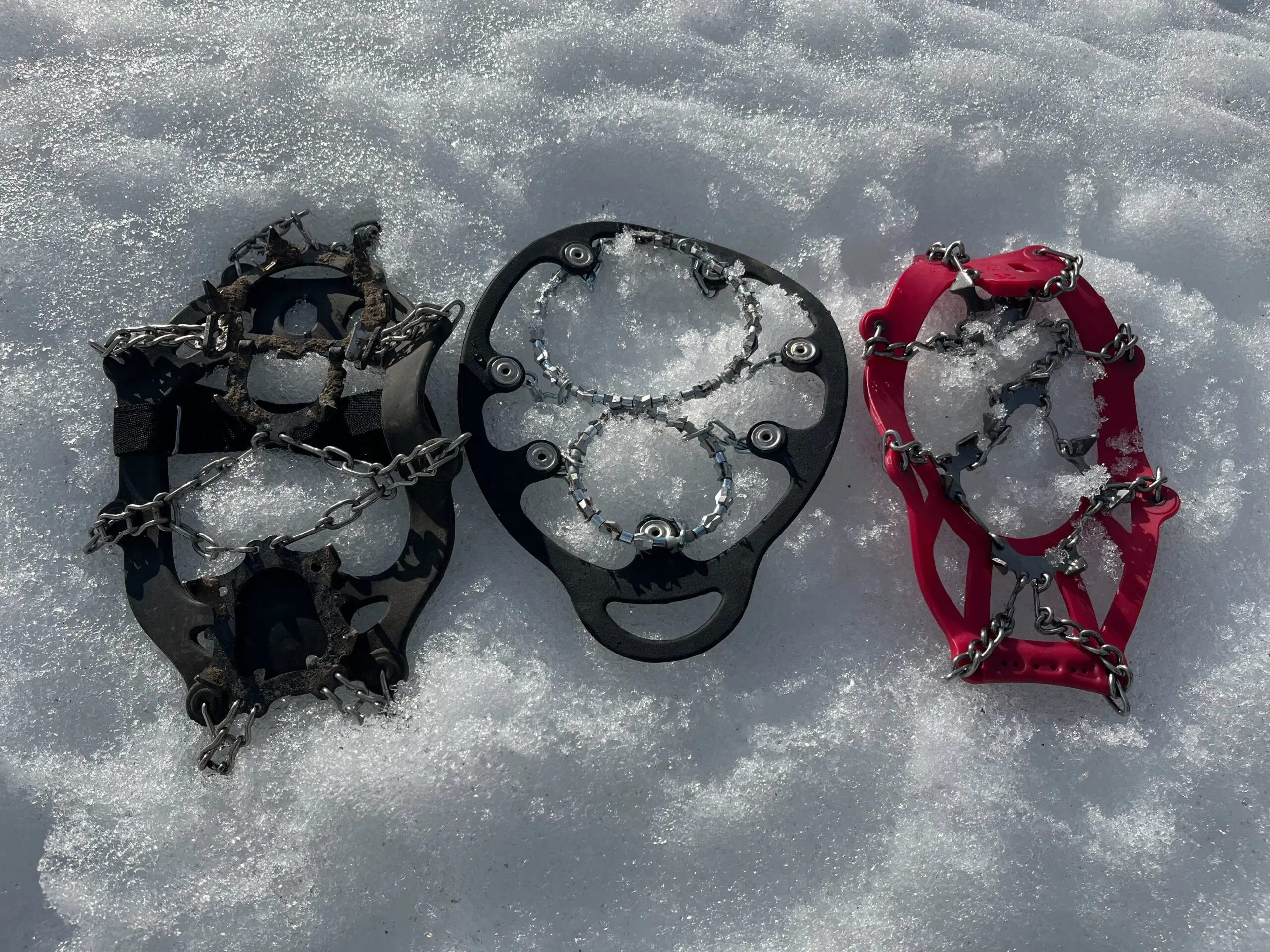
How We Tested the Best Winter Traction Devices
Our Expert Testers
Contributor Maddie Downie conducted the bulk of our winter traction device testing during an especially cold and snowy few weeks in western Washington. Maddie tested these spikes in negative degree temps near the Mount Baker Ski Resort, on a snowy hike near Excelsior Pass, and in town during a rare multi-day snowstorm in Bellingham.
She also had the chance to test a pair on a snowfield at the base of Black Peak earlier in the year. Maddie is unwilling to let the harsh, wet winters keep her from enjoying the outdoors and has miles of spiked treks under her belt both in the damp Washington snow and airy Colorado drifts. Most of all, she knows how unfortunate it is to have a pair of spikes that don’t get the job done.
Editor Chris Kassar also tested a few of these spikes during a few exceptionally icy and snowy Colorado and Wyoming winters and springs. Several times per week, she trekked up the side of a steep canyon through icy trail conditions. In town, Chris ran errands by foot, traversing sidewalks and streets that closely resembled ice rinks. The testing process had real implications — Chris was seeking the best devices to meet her actual day-to-day needs and avoid falling on her butt.
Senior Editor Nick Belcaster also lent a foot or two in testing these spikes, and has years of experience equipping climbers and mountaineers for the glaciers of the North Cascades under his belt. In addition, Belcaster also traversed a snow-bound Sierra Range in 2018 during a thru-hike of the Pacific Crest Trail, where he relied on his traction devices to get him up and over slick mountain passes. His testing today mainly occurs during the fall and winter in Washington State, where having a good pair of spikes is often key to unlocking early-season high-alpine ice.
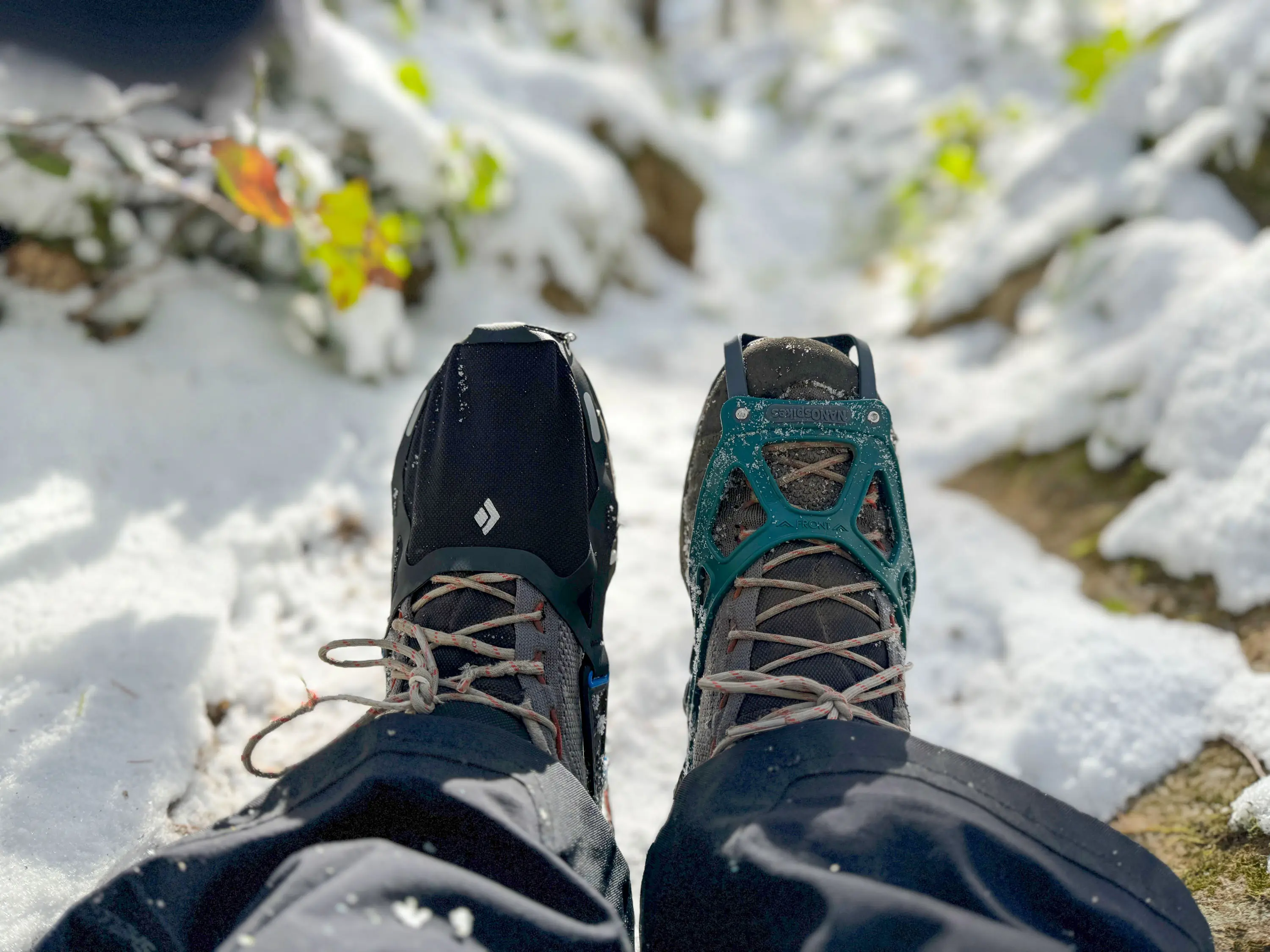



Our Testing Grounds and Process
We put these spikes to the test in order to examine a few key factors: performance over a variety of terrain, harness and fit, durability, and how they held up over long treks. For performance, we intentionally used these spikes in a variety of environments, from snow-packed trails to icy roads and deep cold conditions to autumn glacier travel. From this, we were able to determine if each spike performs well in the conditions they’re made for and if they perform well in any terrains beyond that.
For all tests, we actively compared spikes by wearing two different pairs at the same time (though this did seem to concern other hikers on the trail). This method was especially helpful in comparing performance, harness, and fit. We stretched these spikes over hiking boots, running shoes, and approach shoes to see where they fit best.
To test durability, we tried our best to beat up these spikes. This meant walking over rocks, creeks, asphalt, and whatever harsh terrain we could find. We also took advantage of the negative-degree temps up at Mount Baker to see how each of these spikes handled the super cold!
Testing these spikes over long distances gave us an idea of how comfortable each pair was over several hours. This included seeing how well each pair prevented snow build-up and how well they transitioned between terrains. At the end of the day, we wanted to be sure that each of these pairs could handle your next adventure.
We ran, hiked, and post-holed through it all to find the best of the best. Round out your winter adventuring kit by consulting our buyer’s guides to the best snowshoes, the best winter hiking boots, and the best down jackets.
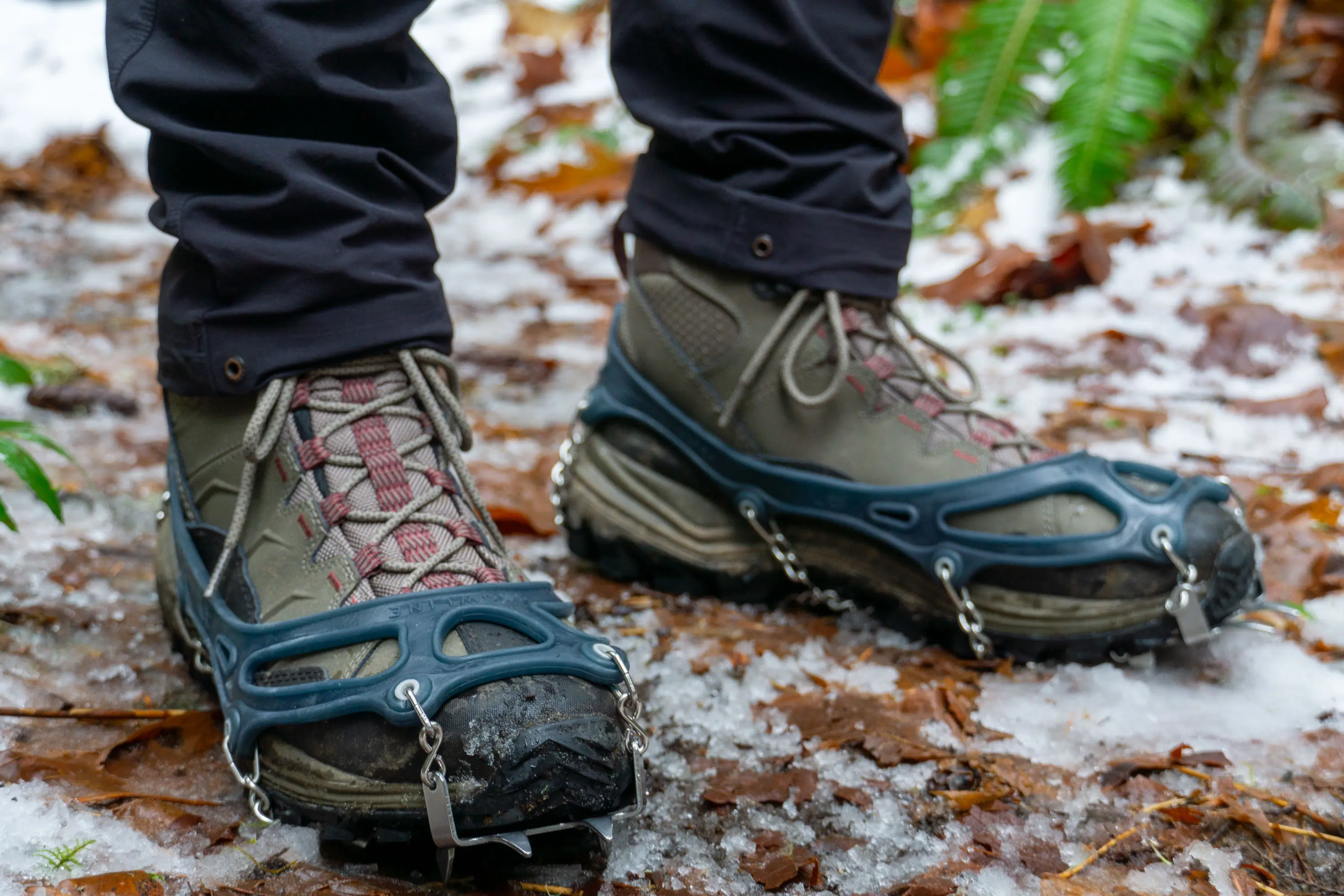



Buyer’s Guide: How to Choose Winter Traction Devices
What Are Traction Devices and How Do They Work?
Most footwear isn’t designed for ice and snow-covered surfaces. Standard rubber-soled boots and shoes are no match for frosted sidewalks and frozen trails. In the cold climates of the northern United States and elsewhere, snow often covers the ground from November to May.
Winter traction devices — also known as ice cleats or microspikes — attach directly to a shoe or boot to bite onto slick surfaces and improve grip. Designs and intended applications vary, but all traction devices are meant to prevent slippage and improve safety.
Some traction devices on this list utilize a pattern of steel coils, while others have cleats or spikes. Every traction device utilizes some kind of harness to snugly attach to a boot or shoe. Traction devices are generally compatible with all kinds of footwear. Ultimately, any traction device is better than nothing, but some work better than others for certain applications.
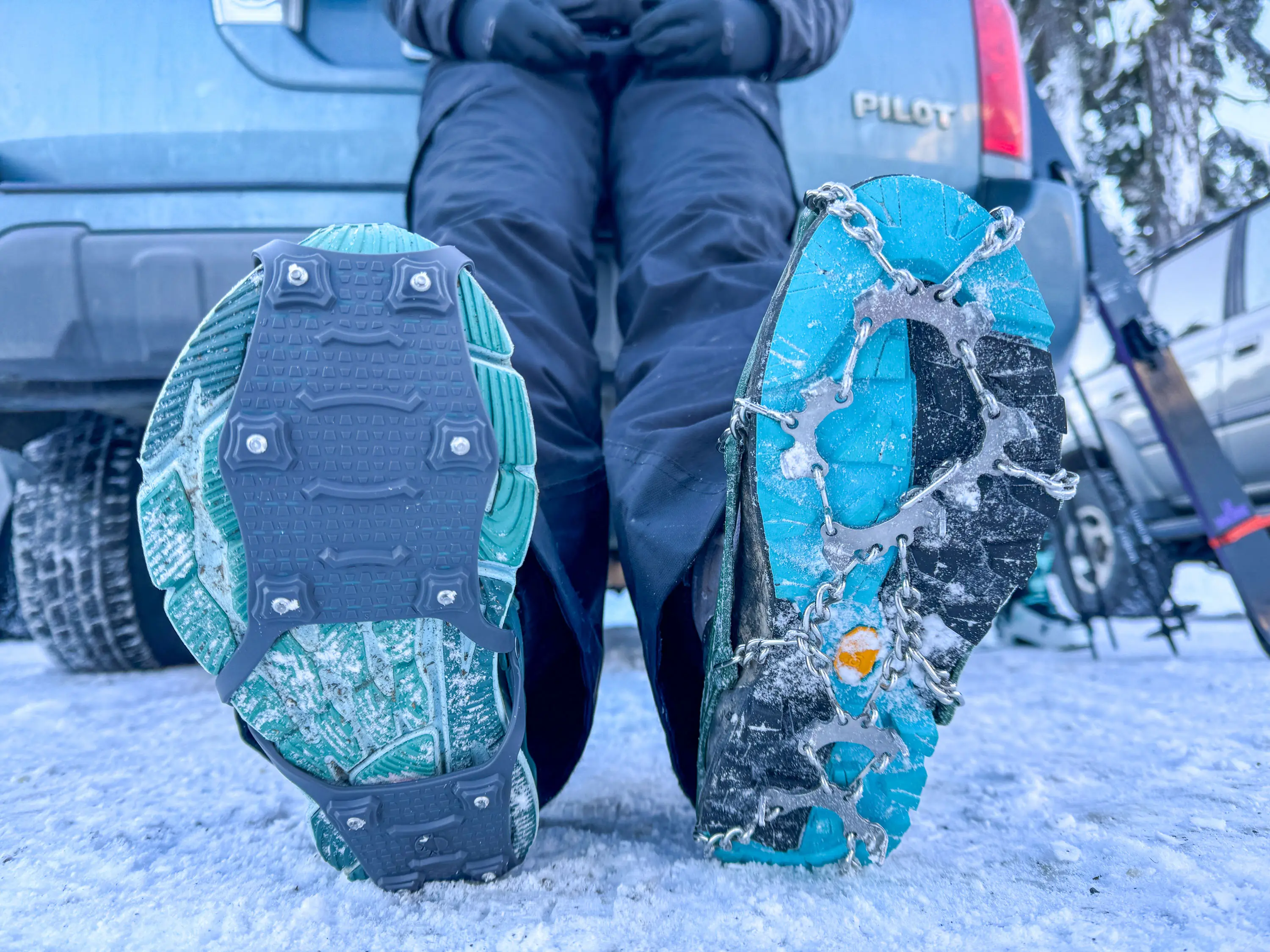



Winter Traction Device Types
Since winter trail conditions can swing wildly not only from day to day, but sometimes hour to hour, equipping yourself with the right spikes for the job will be key in keeping the rubber side down. In the same way that there are varying types of tires you might mount up on your rig, so too are there different types of winter traction devices, and use profiles that they work best in.
Casual/Daily Use
Anyone who has experienced a Minnesota winter knows that it sometimes feels as though they’re running Zambonis around instead of snow plows, and an iced-over city can be a treacherous place to get around, even on foot.
Traction devices for running errands, shoveling out your driveway, or walking the dog aren’t high-intensity, but they still require a good amount of grip to manage. Spikes made for casual use are more often of the coil or stud varieties, with more low-profile traction that is better suited to hardpack and shoveled sidewalks.
The Yaktrax Walk and Black Diamond Blitz Spikes are both tried-and-true low-profile options that that can get most short in-town treks done. They’re perfect for flat surfaces and won’t break the bank.
If you live in a hilly area and require something with a bit more bite, the Yaktrax ICEtrekkers Diamond Grip is a great middle ground. Its free-spinning steel beads are more aggressive than the basic Yaktrax coils, but they’re still relatively lightweight and unobtrusive. For occasional short hikes on unpaved trails, the ICEtrekkers are fully capable.
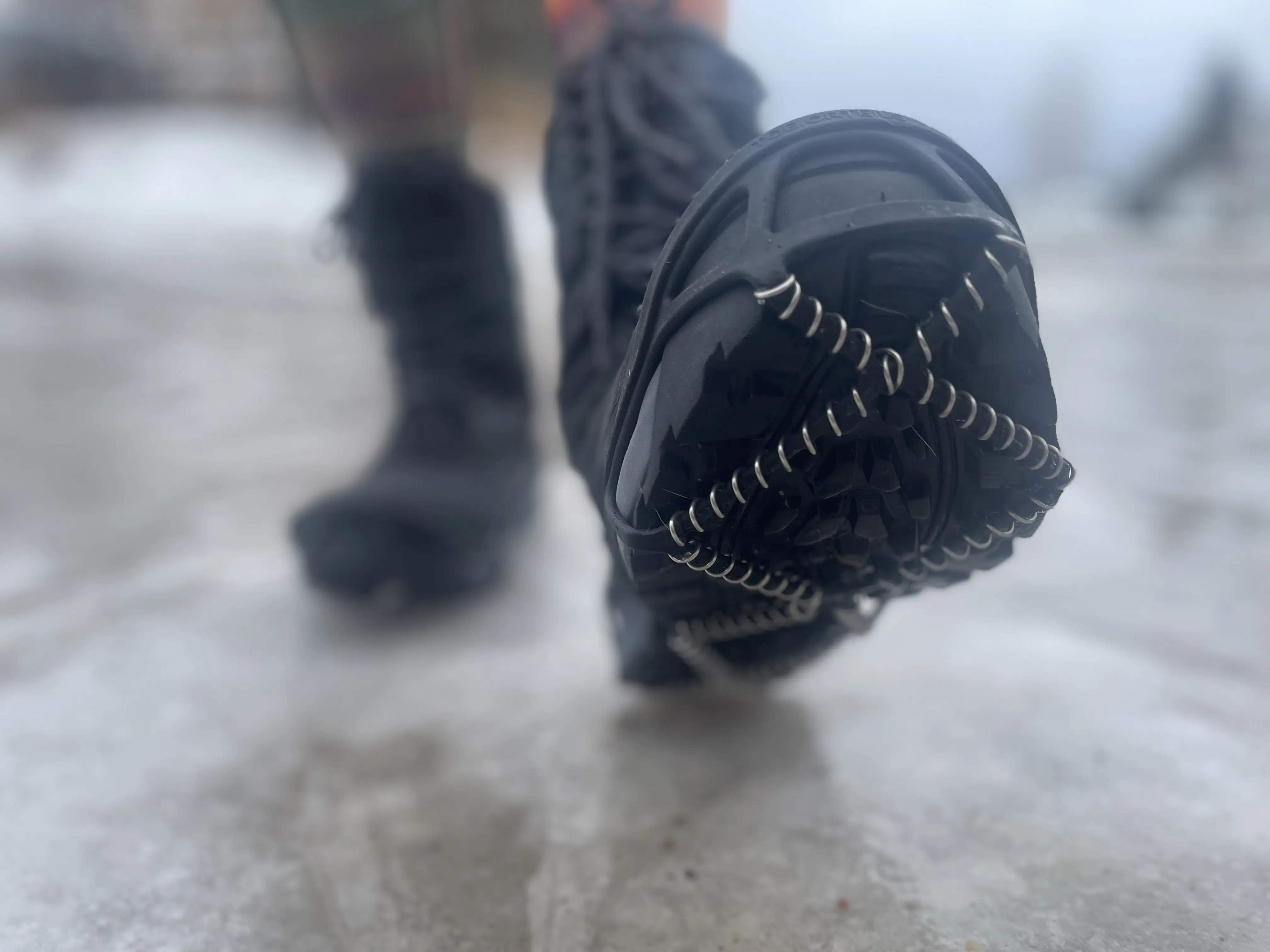



Hiking and Backpacking
Winter traction devices for hiking are a necessity for day-hikers looking to get into the high country, and thru-hikers, too, have a special interest in equipping themselves with the appropriate traction devices, For thru-hiking we choose the Kahtoola MICROspikes Ghost, since time frames don’t allow for perfect mountain conditions, and crossing high alpine passes in the less-than-ideal is made manageable with a good set of spikes.
Obviously, traction in these types of spikes is bolstered over your daily-driver types, with not only the depth of the spikes increasing but also their number and distribution under the foot. Coil-type traction works best on packed-out and icier trails, and as such, devices with actual spikes are preferred for hiking.
When headed out on a snowy hike, we most often reach for our Kahtoola MICROspikes to provide the traction we need. For much deeper or steeper snow, the mountaineering crampon-adjacent Kahtoola KTS Hiking Crampons bulk up on traction with ten spikes that grip 1″ into the ice.
Alternatively, the Hillsound Trail Crampons have 11 carbon steel spikes that grip a full 2/3″ into the substrate. Both of these spikes have serious bite.
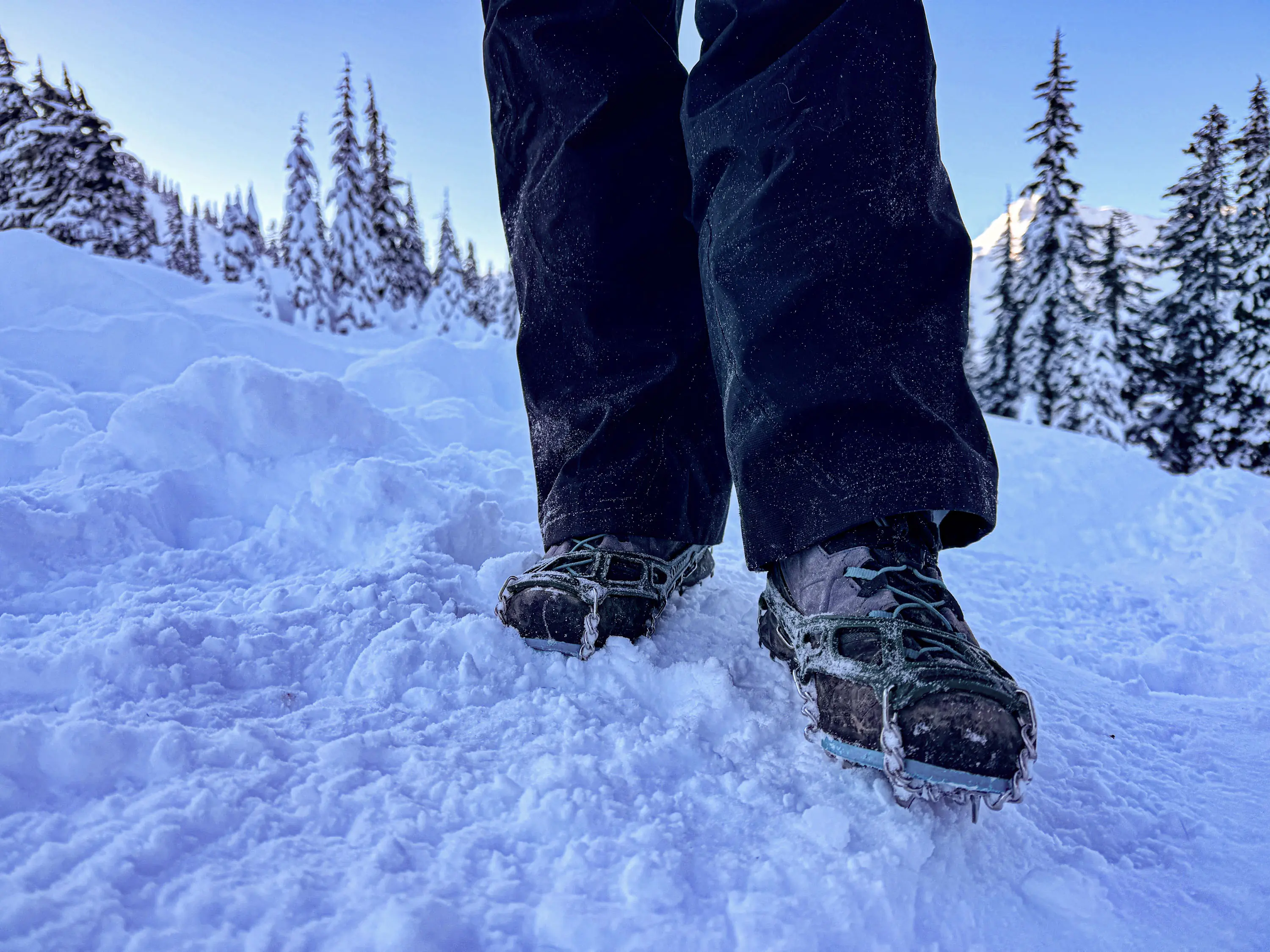



Running
Your heart rate doesn’t have to drop when the temperatures do. Running traction devices have a slightly different approach than their slower-paced counterparts. They aim to have a robust harness system that won’t slip off during use, and just enough traction to bite in without tripping up your stride.
Studs are the end-all when it comes to running-style traction on compacted terrain, as they clear irregularities on the ground better than spikes, and won’t roll as coils will. The Korkers Ice Runners sport 22 of the steel carbide bits and feature a BOA-cinched harness that cradles the top of the foot in a way that most other devices couldn’t match.
The Kahtoola NANOspikes have a less intense harness but have plastic ridges that bite onto the tread on the bottom of your running shoes to prevent slippage. For deeper or ungroomed trail running in the snow, it can make sense to go with a spike that has a bit more bite, like the Black Diamond Distance Spike, which has more pronounced studs to dig in deeper.
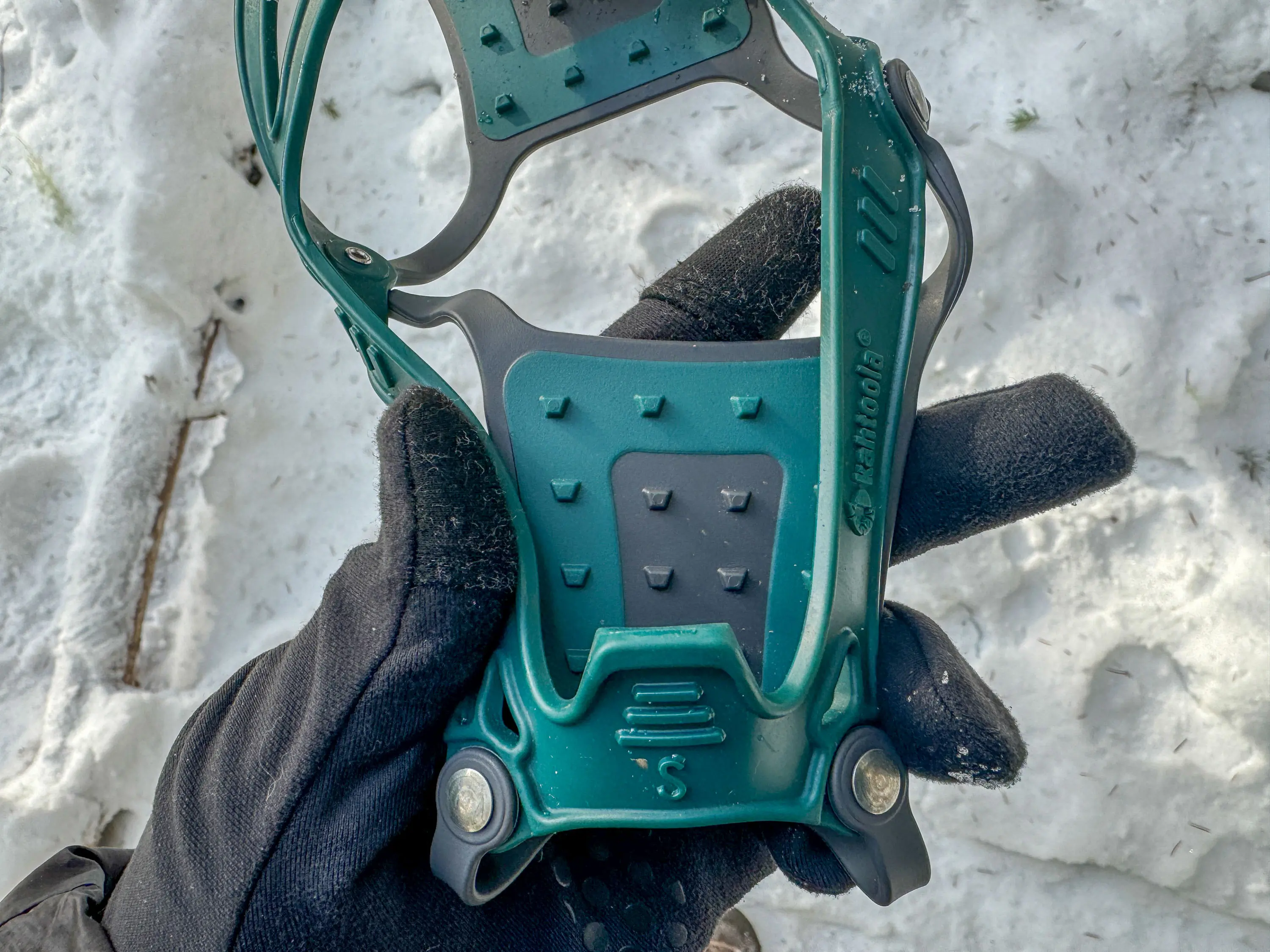



Traction Styles: Coils vs. Studs vs. Spikes
Traction devices rely on a variety of materials and designs to improve grip. The ubiquitous Yaktrax Walk and Yaktrax Pro Traction have a series of steel coils that run in an X-shaped pattern from toe to heel. While coils are a reliable option for non-technical everyday use, they aren’t as aggressive or biting as metal studs or spikes.
Studs — or cleats — are small metal points typically no thicker than the tip of a pen. These points are usually made from ultra-hard carbon steel compounds called carbide. They work exactly like football cleats, stabbing into the ice with every step. Studs are the preferred traction solution for runners, as they are lower profile and shallower than spikes.
On this list, the Korkers Ice Runner, Kahtoola NANOspikes, and the Kahtoola EXOspikes utilize replaceable steel carbide studs to ensure runners and walkers can traverse icy sidewalks and snow-packed trails. great effect.
Teeth-shaped crampon-style spikes tend to be more aggressive than coils or studs. Steel spikes dig deep into the snow, ice, mud, and dirt. For steep technical hiking, spikes are the most secure choice. On this list, the Hillsound Trail Crampons have the most rugged spikes that are great for serious winter hikes. They won’t work for climbing vertical terrain, but they’re great for trekking in the mountains.
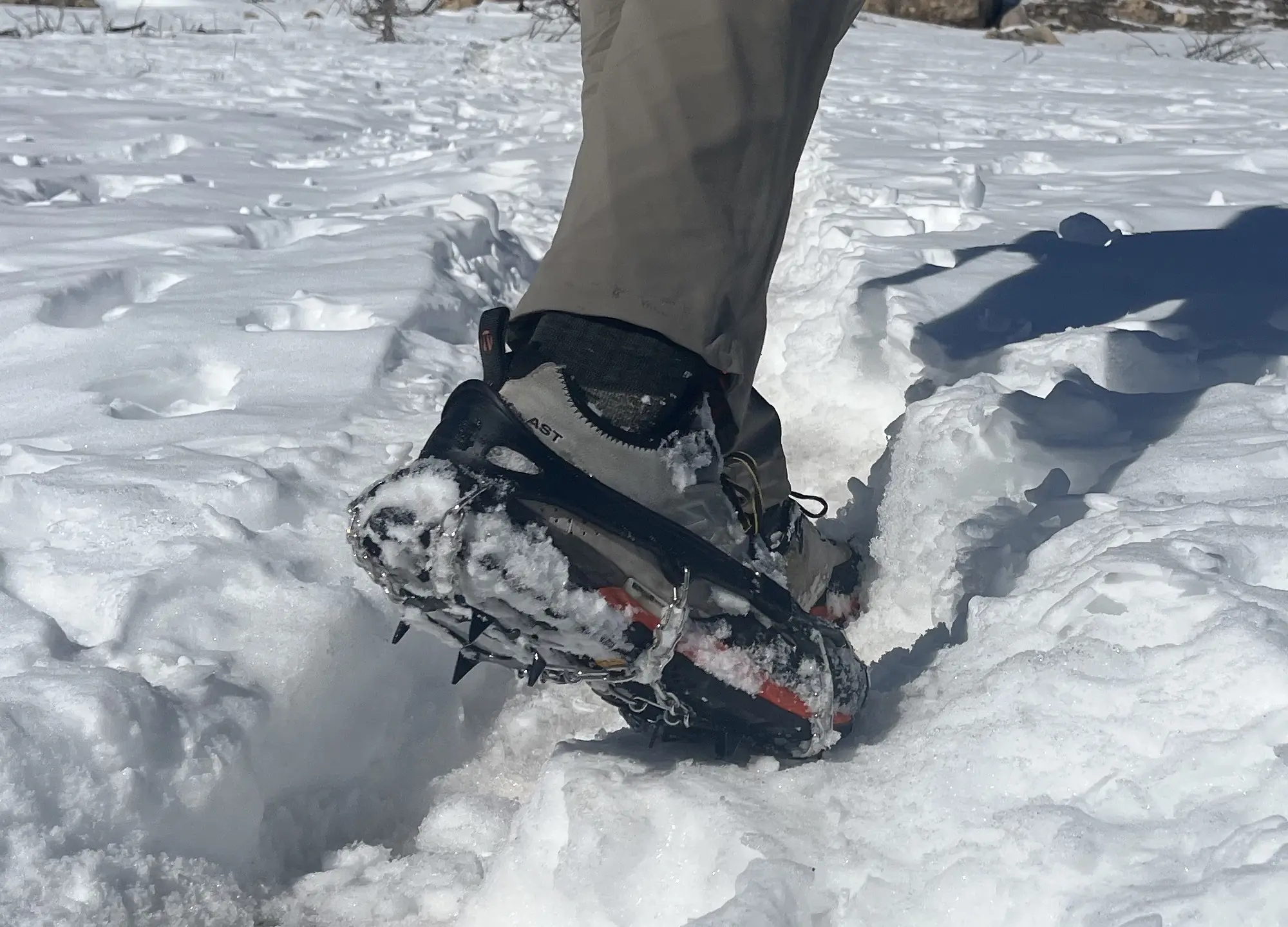



Length and Number of Spikes/Studs
Traction devices with spikes aren’t automatically “better” than those with studs or coils. No matter which traction system you go with, consider the length, distribution, and total number of studs, spikes, or coils.
If pure traction is your priority, look for a device with coils, studs, or spikes across the entire underfoot area. Some styles, like the Black Diamond Blitz, only have spikes in the forefoot. While this minimalist design improves packability, it increases the potential for slipping and falling.
Typically, 10-12 evenly distributed studs or spikes like we see in the Black Diamond Access Spikes will provide the best grip and performance for winter walks and hikes. As for coils, the Yaktrax Pro and Yaktrax Walk have coils that stretch across the whole foot.
As for length, longer spikes and studs are more aggressive, which is helpful on steep and rough terrain. The most rugged traction devices have long spikes and a lot of them. Hillsound’s Trail Crampons have long 17 mm spikes that dig deep into snow and ice, and the Snowline Chainsen Ultras sport two front points to dig into steeper ground.
Long spikes can be a nuisance for runners, as they tend to disrupt the user’s natural stride. For general use, the Snowline Chainsen Light Spikes have shallow spikes, which are sufficient for most users.




Harnesses
Traction devices use harnesses to remain firmly fixed to the user’s foot. Typically, harnesses are made from rubber or a rubber-plastic compound, which has elastic qualities and holds up to abuse. With that said, some harnesses are more durable than others, and they tend to be the first component to fall apart. A good well-fitted harness keeps the underfoot traction system from sliding around.
On this list, the Hillsound Trail Crampons have a durable harness that is both secure and lightweight. It’s easy to put on and take off with its sizable pull tab, and the eyelets that hold the traction system are thick and reinforced. On the other end of the spectrum, the ICEtrekkers Diamond Grip has a semi-thin standard rubber harness that feels less durable.
While most harnesses simply stretch around the outside of a shoe’s sole, some are more advanced. The Korkers Ice Runner uses a BOA adjustment system to fully sandwich the foot between two contoured plates. The resulting fit is exceptionally secure — which is exactly what runners need.
The Black Diamond Distance Spikes are especially unique in their harness design. These spikes have a harness with a soft shell toe cover that keeps loose snow out of your shoelaces, though it won’t necessarily keep your toes any warmer!




Weight
Naturally, minimalist options like the Black Diamond Distance Spikes and Blitz Spikes weigh less than 5 ounces, while the aggressive Hillsound Trail Crampons are relatively hefty and weigh about a pound.
As weight increases, so do durability and overall grip. More spikes and thicker harnesses improve performance, but the ounces do add up. For everyday comfort, it’s nice to stick to lighter options. On this list, Kahtoola’s EXOspikes weigh just 11 ounces per pair — an excellent middle ground of weight and all-around performance.
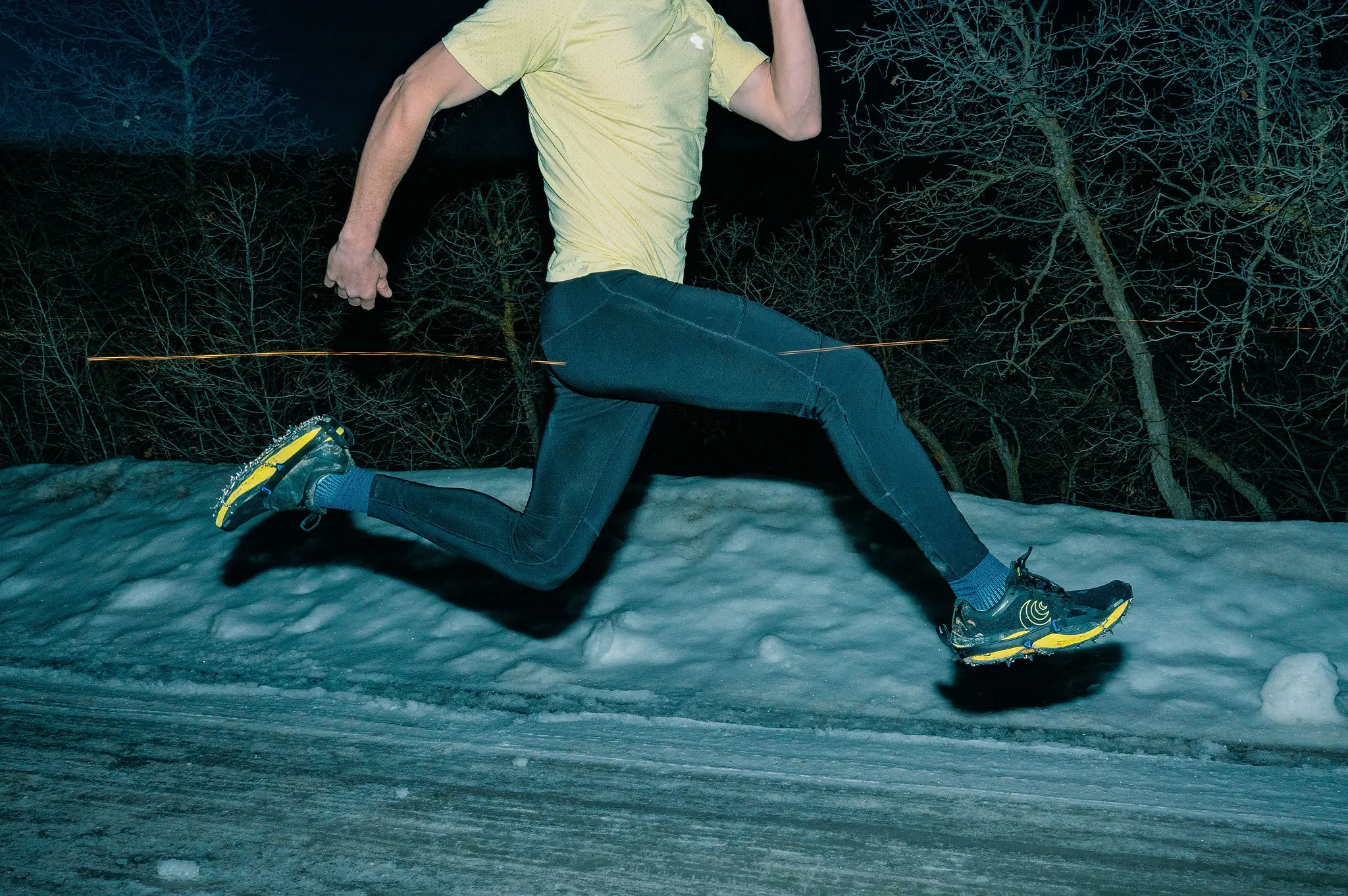



Packability
Packability is a concern for outdoorsy folks who will need to carry their microspikes when they’re not in use. Ultralight fanatics should check out Black Diamond’s minimal Distance Spikes — which pack down to the size of an apple and weigh less than an iPhone. However, they should keep in mind that lighter spikes usually mean less durable spikes!
A more durable model may sacrifice the packability. The Hillsound Trail Crampons aren’t very packable, but that’s the price you pay for long spikes and a heavy-duty harness.
Most spikes come with a designated pack. The Kahtoola spikes in this lineup come with synch packs that even have a space for your name on the front. The Snowline Chainsen Spikes have a zippered pack that we enjoyed. We found it easy to store many of these spikes in hip pockets of backpacks as well, if you want to keep things even lighter.
We especially loved how storable the Kahtoola NANOspikes are. Just like a wallet, they can be folded and stuffed into pockets. Just don’t forget about them in the wash!
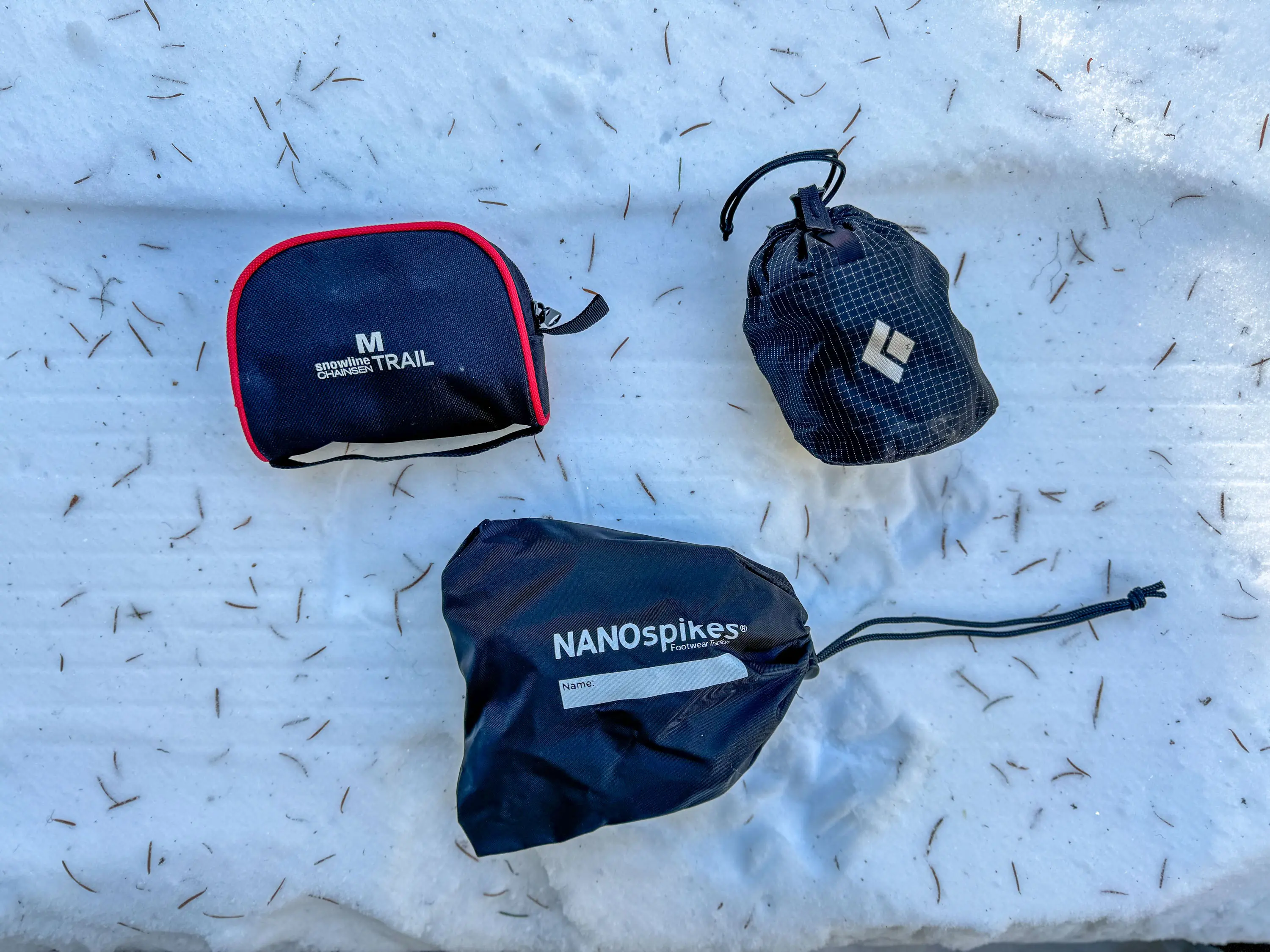



Sizing
Before rushing to purchase a pair of spikes, it’s important to take a long look at each brand’s sizing guide. These guides tend to vary between brands. For instance, while the Kahtoola size guide begins with “small” (or “extra small”), the Snowline guide starts with “medium,” though technically, the small Kahtoola sizes are larger than the medium Snowline sizes.
Size guides are generally multi-part. While these traction devices are unisex, their size guides do account for size differences in U.S. men’s and women’s footwear. If your footwear is also unisex or if you’re not sure which label they fall under, most size guides will include EU sizes. You can find EU sizes on most shoes and boots even if they’re a U.S. brand.
Most size guides will have a second part for types of footwear. These are split into two categories: shoes and boots (though Kahtoola uses “hiking boots” and “insulated boots” for its MICROspikes). This is an important consideration, and you should take the time to determine which footwear you’ll use most often with those spikes.
Keep in mind that some sport-specific spikes, like the NANOspikes that are made for runners, will generally only have a size guide for one type of shoe (running shoes in this instance).
Though we don’t recommend betting on it, there were several spikes in this lineup that fit over running shoes, light hiking shoes, and hiking boots. The Kahtoola MICROspikes were a pair that fit on a variety of different footwear, though it definitely took some stretching to get them over the heftier boots.
In our experience, the guides provided on brand websites are accurate. However, if you’re seeking a precise fit for running or technical hiking, look for a model with a customizable harness, such as the Korkers Ice Runner.
Temperature Ratings
In extremely cold temperatures, rubber traction device harnesses can become brittle and snap. All of the recommendations on this list are built to handle freezing temperatures, and most users will not encounter an issue.
However, If you plan to use your microspikes in the Arctic tundra, for example, it’s worth checking the temperature rating. On this list, the Snowline Chainsen Spikes are equipped to handle the coldest of the cold; they’re usable down to -76 degrees F!
These were the only spikes that were effortless to pull on during the -20-degree weather at Heather Meadows. The next best spike is the Yaktrax Pro which can withstand temps down to -41.
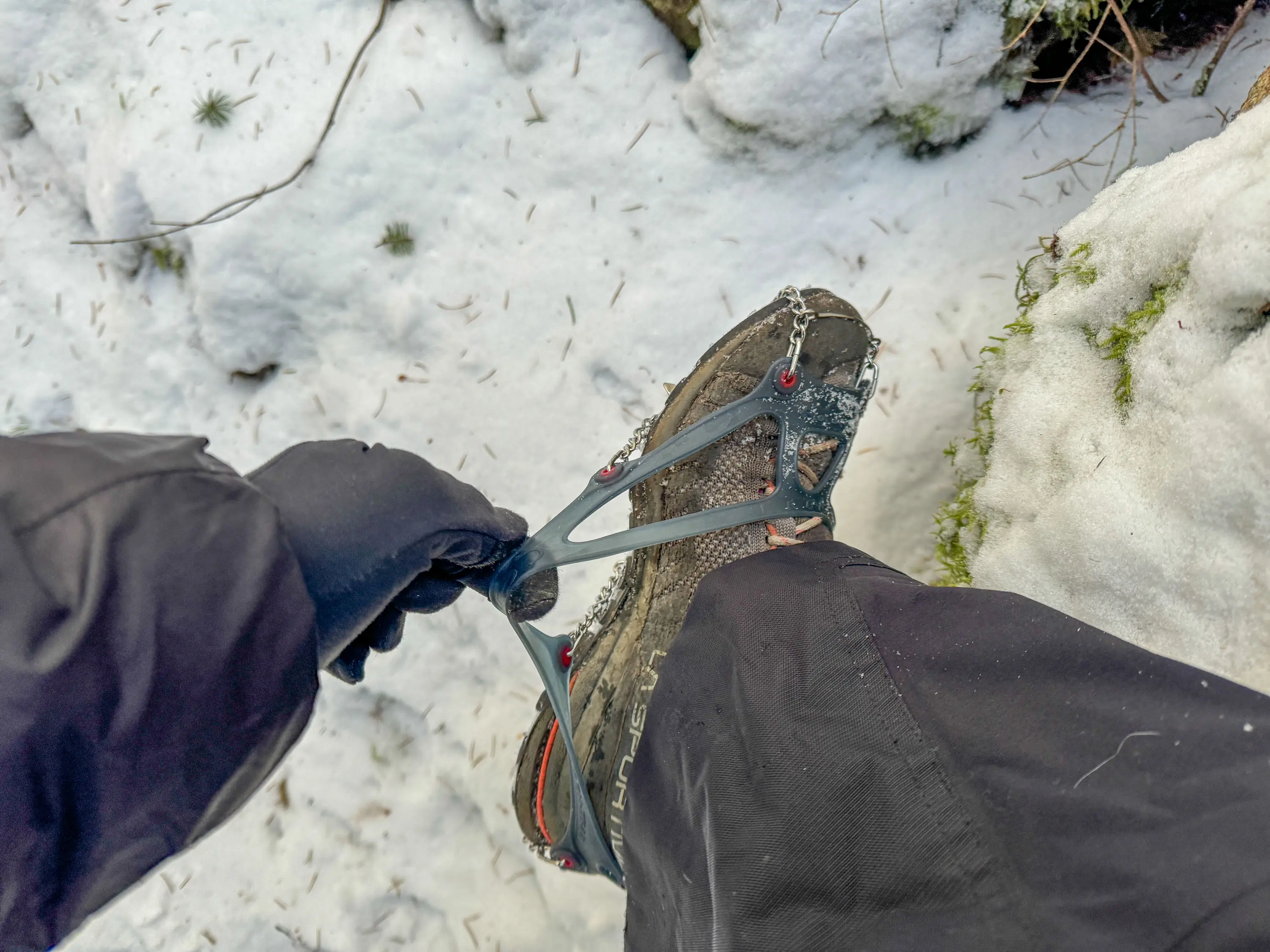



Traction Devices vs. Crampons and Snowshoes
Winter traction devices are different from crampons and snowshoes. Crampons often look like a more intense version of a traditional microspike, and that’s because they are. Crampons have significantly larger metal spikes that aid climbers in ice or mixed climbing or traveling over crevassed glaciers or other technical terrain.
Crampons have a specific fit for different types of mountaineering boots and won’t attach easily to non-technical hiking boots or shoes. None of the traction devices in this list should be used as a crampon alternative in technical terrain.
Snowshoes look less like traction devices than crampons do. The large footprints on snowshoes use surface area to keep a hiker from post-holing through deep snow. The bindings on snowshoes will attach to most winter footwear.
Snowshoes are best used to travel over fresh and deep snow, but not to maintain traction on icy terrain. For deep snow travel, think snowshoes; for icy or snow-packed travel, think microspikes.
If you’re seeking gear for technical ascents, look for a pair of bonafide crampons. If you need a wider platform for staying afloat in soft snow, check out our favorite snowshoes.
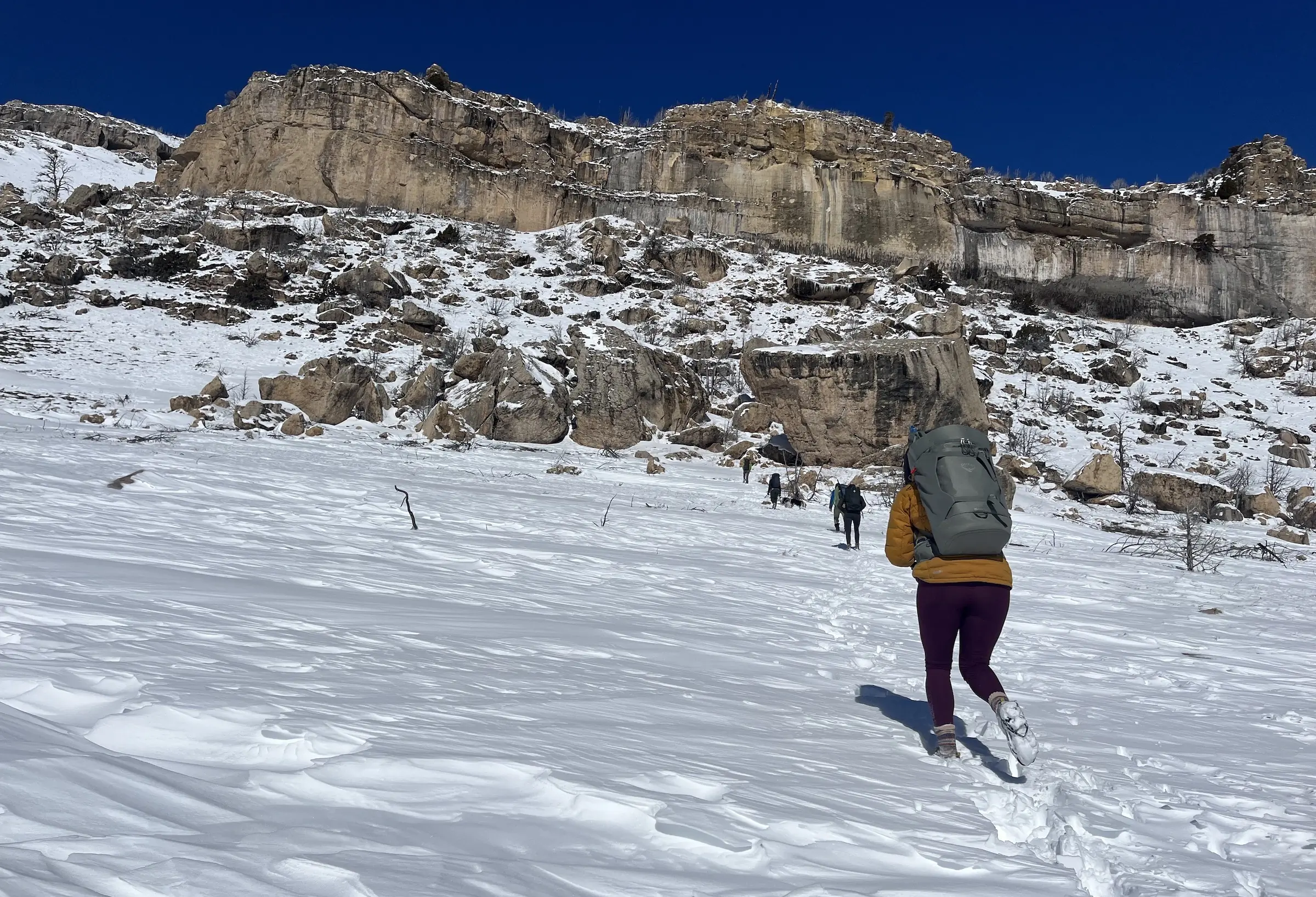



Price & Value
Budget
You can pick up a budget traction device for $40 and under. The Yaktrax Walk and Yaktrax Pro Traction ($40) are the only true budget options we reviewed, but there are others on the market. For this price, you get moderate traction that works for everyday walks on graded surfaces. However, this level doesn’t deliver durability or performance on technical terrain or for vigorous activities.
Mid-Tier
Most of the traction devices we reviewed fall in this category, ranging in price from $50 to $75. Our top overall pick, the Kahtoola MICROspikes ($75), delivers ideal traction, reliability, comfort, and durability; plus, they’re versatile and easy to use. The Snowline Chainsen Light Spikes ($68) excel in frigid temps and perform extremely well.
Mid-tier traction devices meet the needs of most outdoor enthusiasts who enjoy winter or spring hiking in snowy or icy conditions. The products at this level aren’t as durable or aggressive in terms of traction as those in the premium category, however.
Premium
Winter traction devices for $80 or more fall in the premium category. They typically have more aggressive traction and are helpful for steeper terrain. The Kahtoola KTS Hiking Crampons ($170) employ 1” steel spikes that tear into snow and ice to offer unparalleled security for non-technical mountaineering, winter peak bagging, or spring adventures above treeline.
Similarly, the Hillsound Trail Crampons strike a nice middle ground between basic microspikes and true alpine crampons. Options in this category have very specific use cases, meaning they won’t work for casual walks around town. They only excel on steep slopes covered in snow or ice. While most readers won’t need this much security, those who do will appreciate having bomber spikes to keep you from slipping up.
Frequently Asked Questions
Prices vary, but winter traction devices are quite affordable. For a simple pair for in-town use, expect to pay between $20 and $50. For a more capable hiking pair, you’ll be looking at $40 all the way up to $80 for something like the Snowline Chainsen Ultras. On this list, the Yaktrax Pro ($35) offers outstanding value.
When not in use, keep your microspikes clean, dry, and above freezing. If they’ve become caked in mud, give them a quick rinse before storing them away. An entryway shoe cubby is the perfect storage spot.
Some icy surfaces are naturally gripper than others, but in any case, traction devices are a great idea. Many people go without microspikes for their whole lives without issue, but wearing a pair certainly decreases the risk of injury. Often, once a person wears a pair for the first time, they realize the immense benefits and never go back.
Plainly, microspikes are best thought of as the “on-trail” version of crampons, which are mountaineering-specific traction devices meant to be used on the permanent snowfields and glaciers of alpine climbing routes. Utilizing one for the other is often a recipe for an uncomfortable time out in the hills, though there is crossover terrain that some may opt for a lighter version of traction to shave weight on their back.
For one, microspikes utilize an easy to adjust elastomer harness system that makes them amenable to pretty much any type of footwear, while crampons are available in both full-strap, semi-automatic, and fully-automatic harness versions. All of these require the sturdy shank of a mountaineering boot to work properly.
In addition, microspikes are, well, micro, with much shorter traction points compared to their alpine brethren. The longest microspike points are typically less than ½”, while crampon points can reach an 1½” or more. Some, like the Snowline Chainsen Ultras, feature short front points similar to those found on mountaineering crampons.
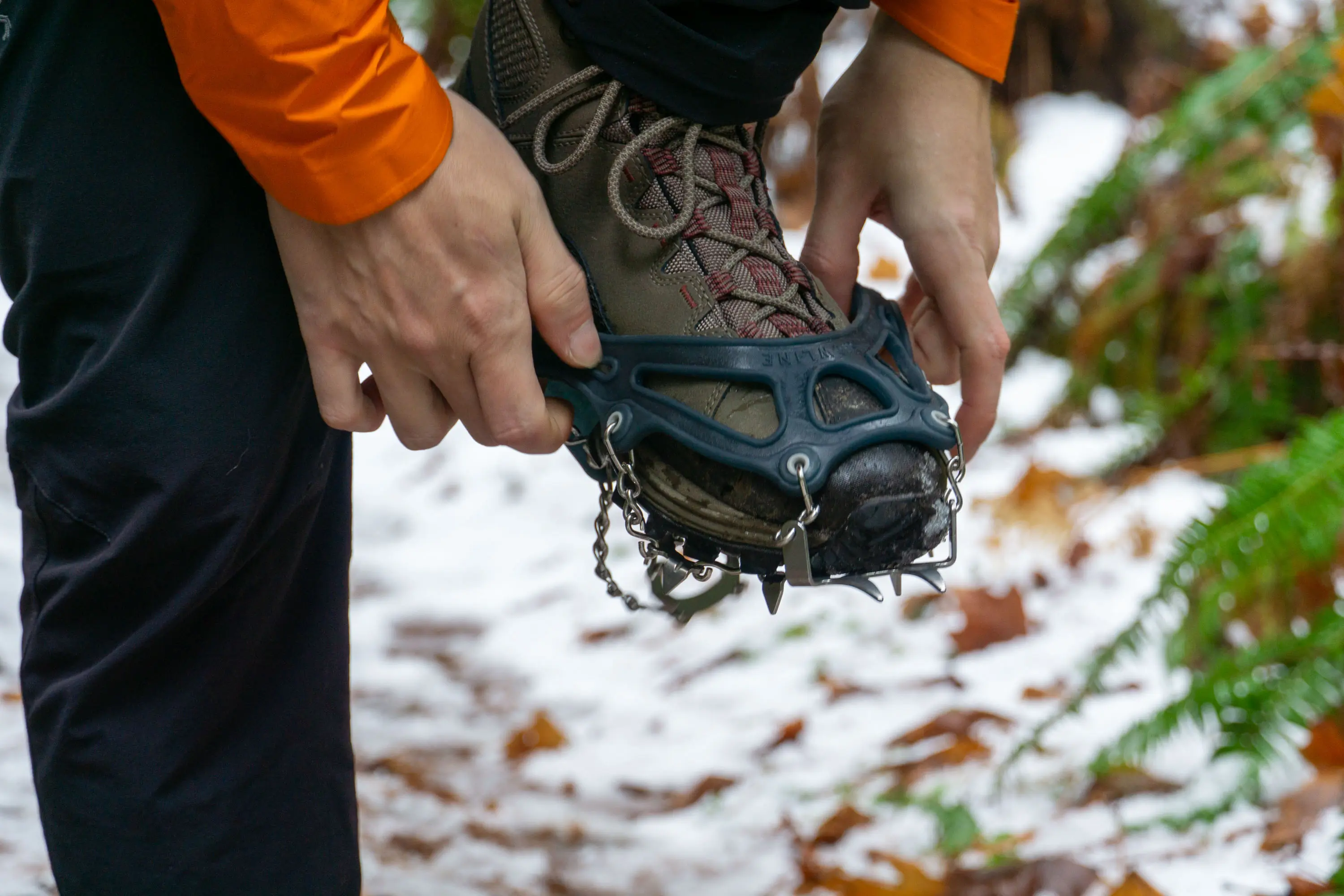



Due to their durable elastomer and steel chain design, there’s little reason to avoid rocks while wearing microspikes, and indeed better traction may sometimes be found by walking on rocky terrain. It should be noted that this can increase the wear on your microspikes, but it is not outside the regular use anticipated for them.
The beauty of microspikes is that their easy-to-use harness systems make them compatible with many different types of footwear. Generally, most will use their winter hiking boots or trail runners, though with the proper size, microspikes can even fit on ski boots for a non-slip walk across the ski area parking lot.
Be mindful of the different styles of footwear you plan on using your microspikes for, as their size range may not accommodate all of the different boots and shoes you’d like to use them on.


The Best Snowshoes of 2025
We tested the best snowshoes from MSR, Atlas, Tubbs, and more to help you find the best option for your needs and budget.
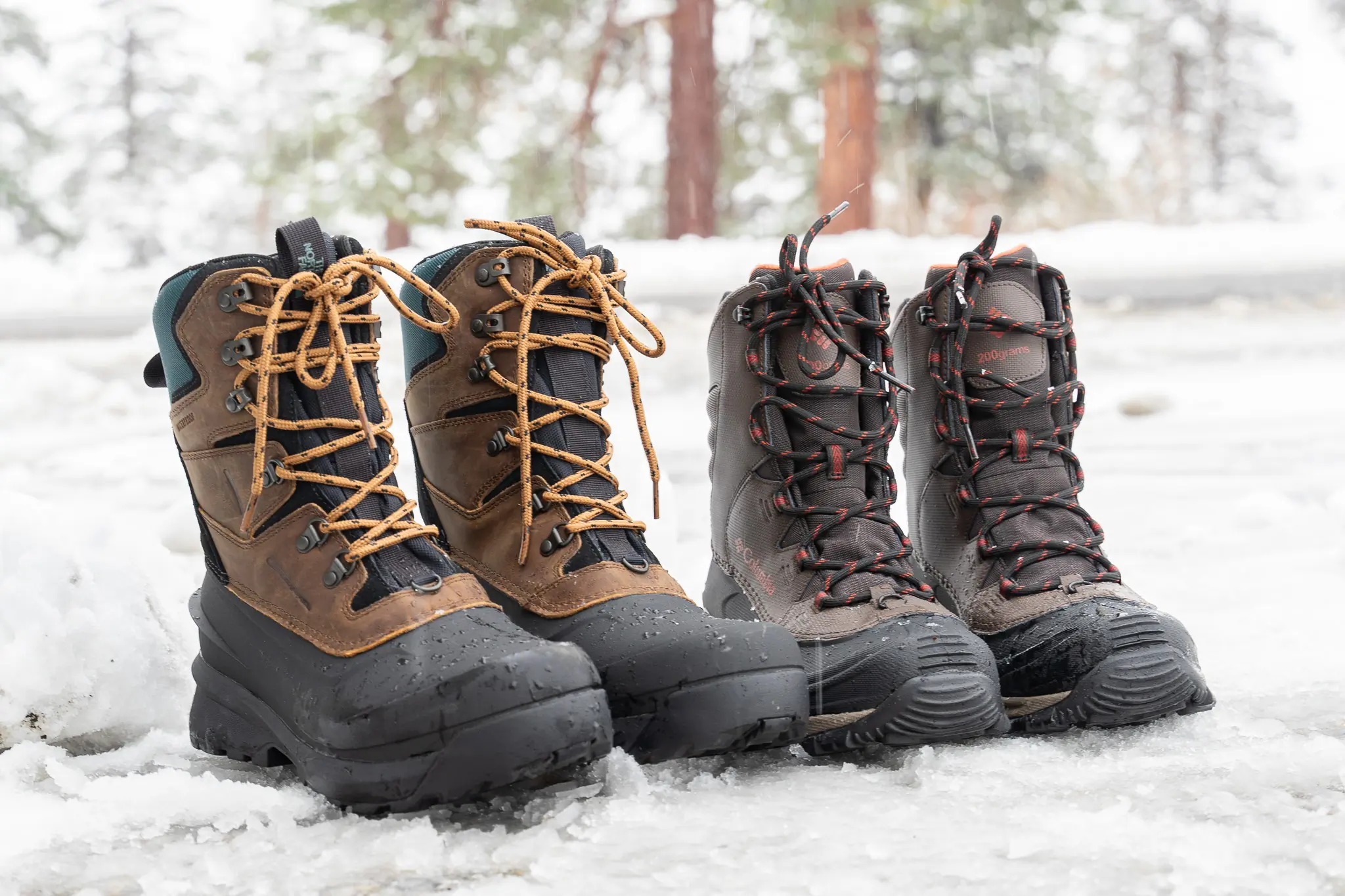

The Best Winter Hiking Boots of 2025-2026
When snow and ice take over, the best winter hiking boots deliver warmth, traction, and protection that won’t quit. We tested top options from KEEN, Columbia, The North Face, and Hoka to keep you moving through the coldest trails.
